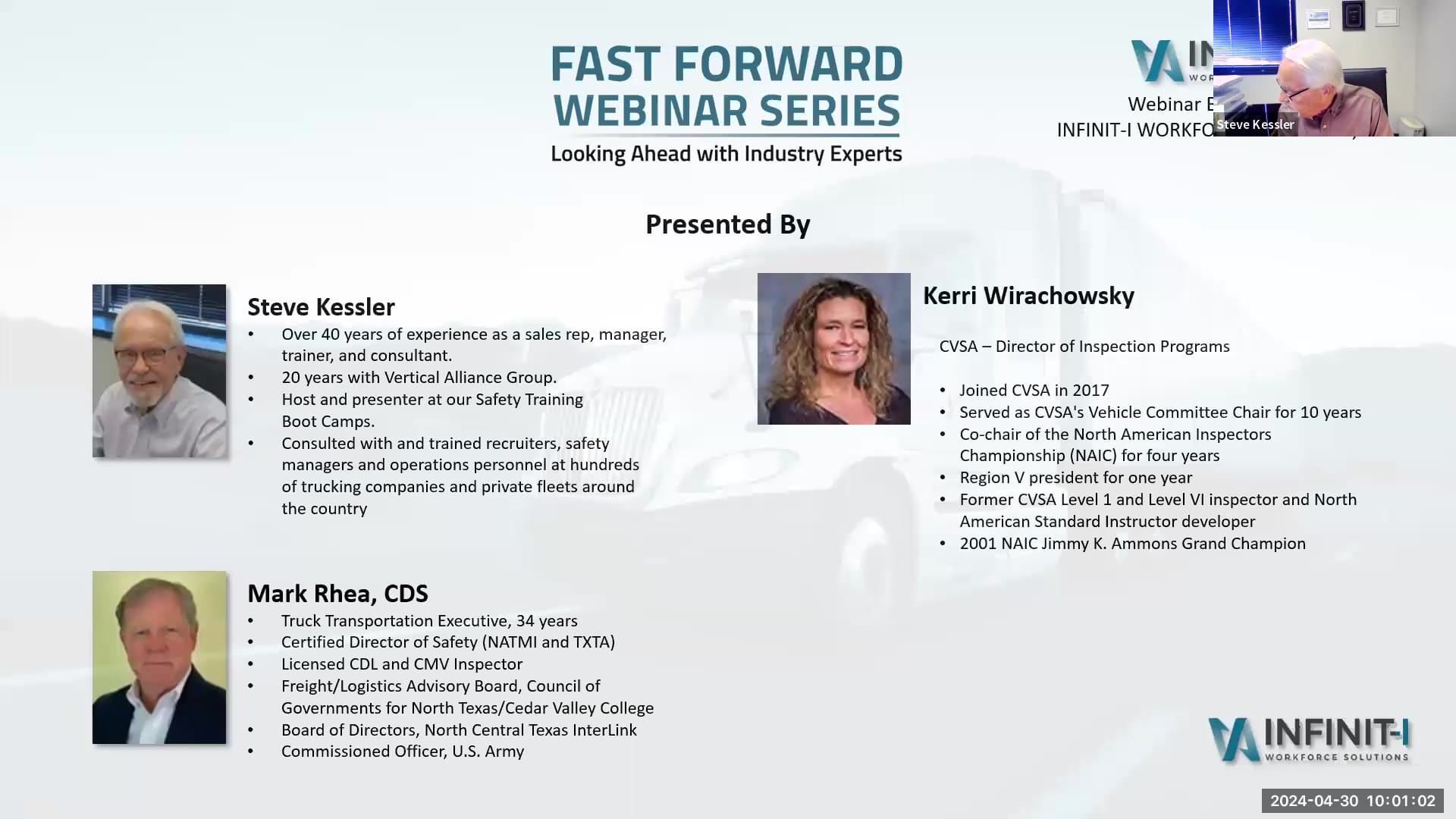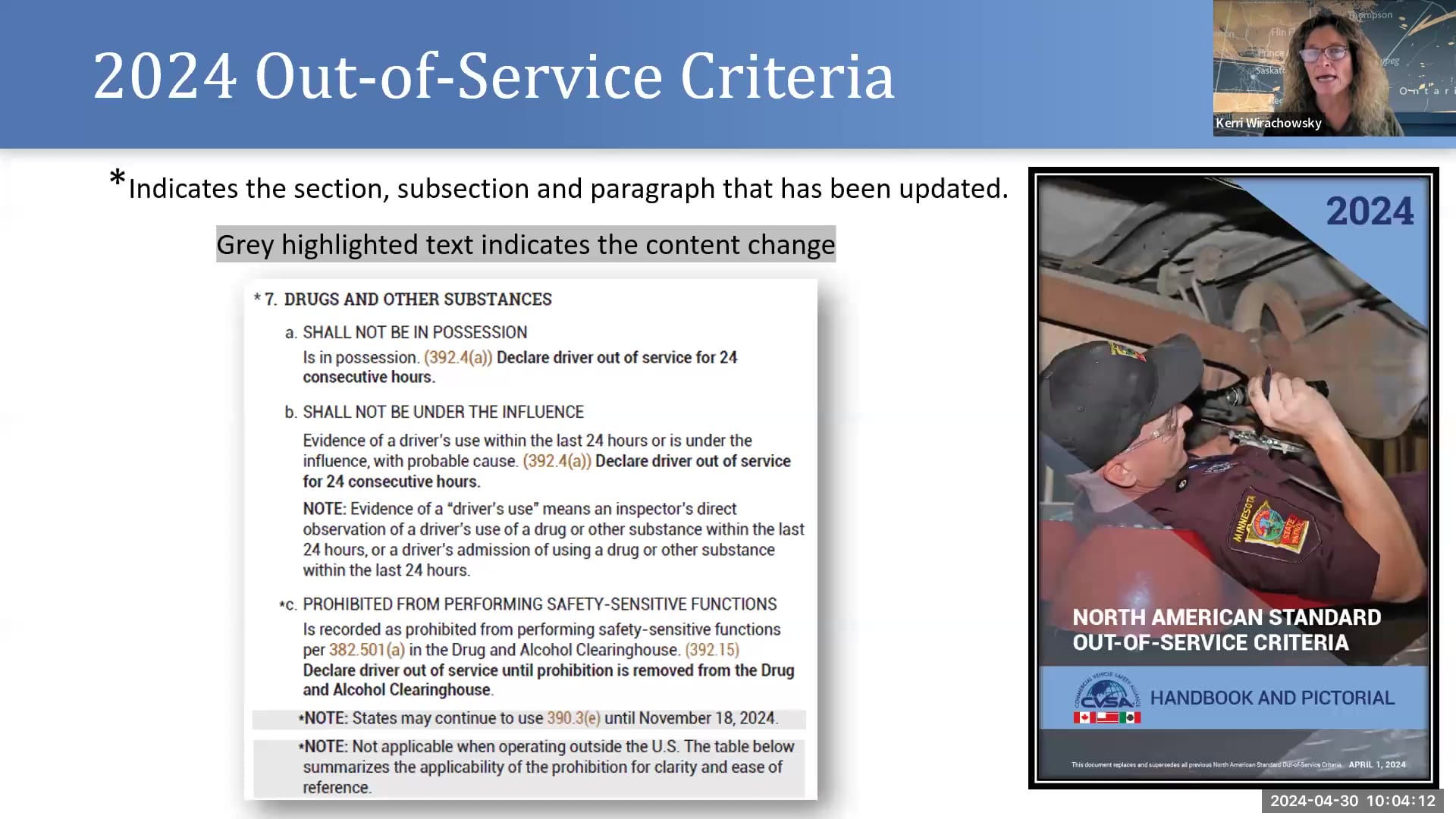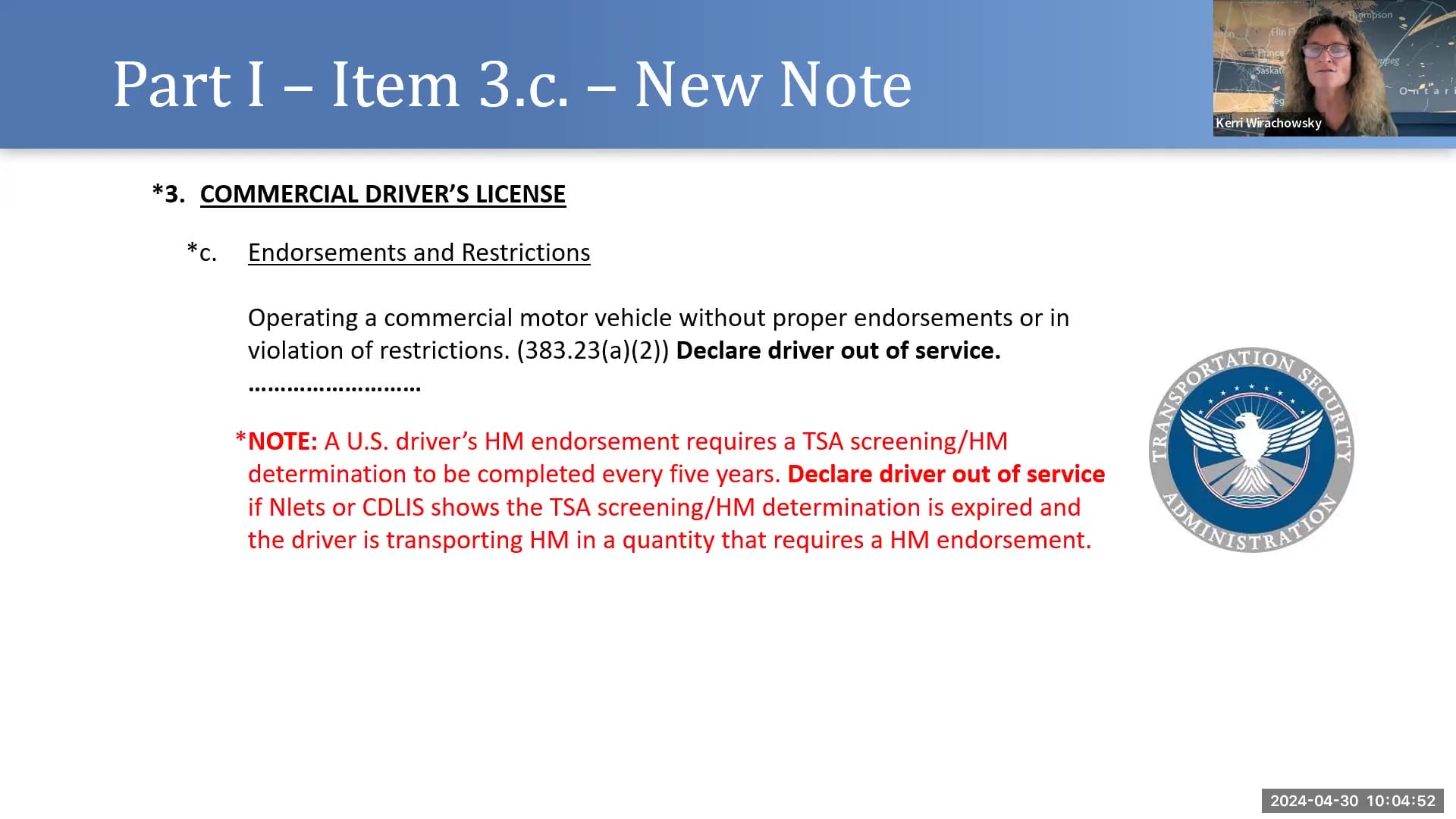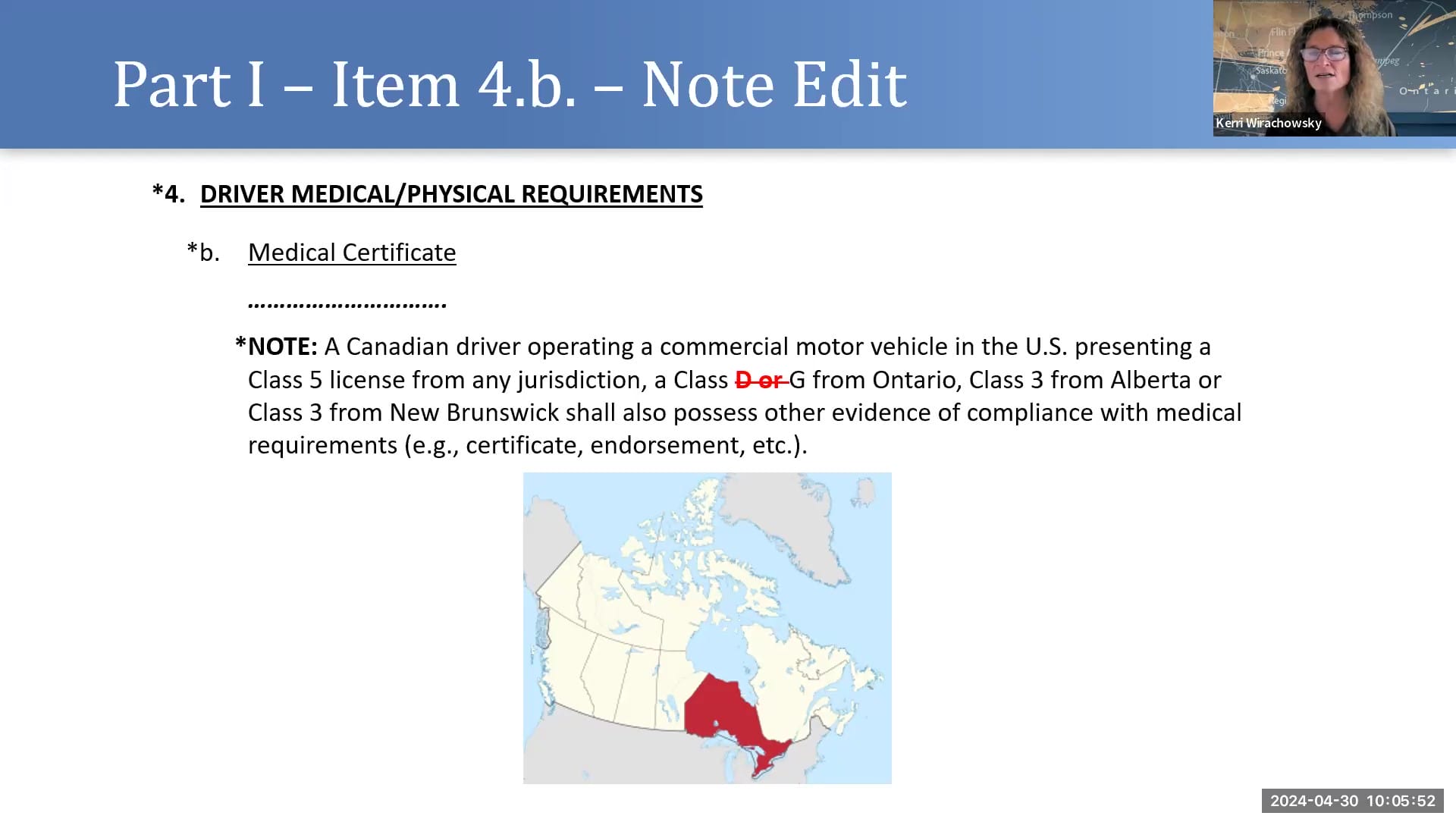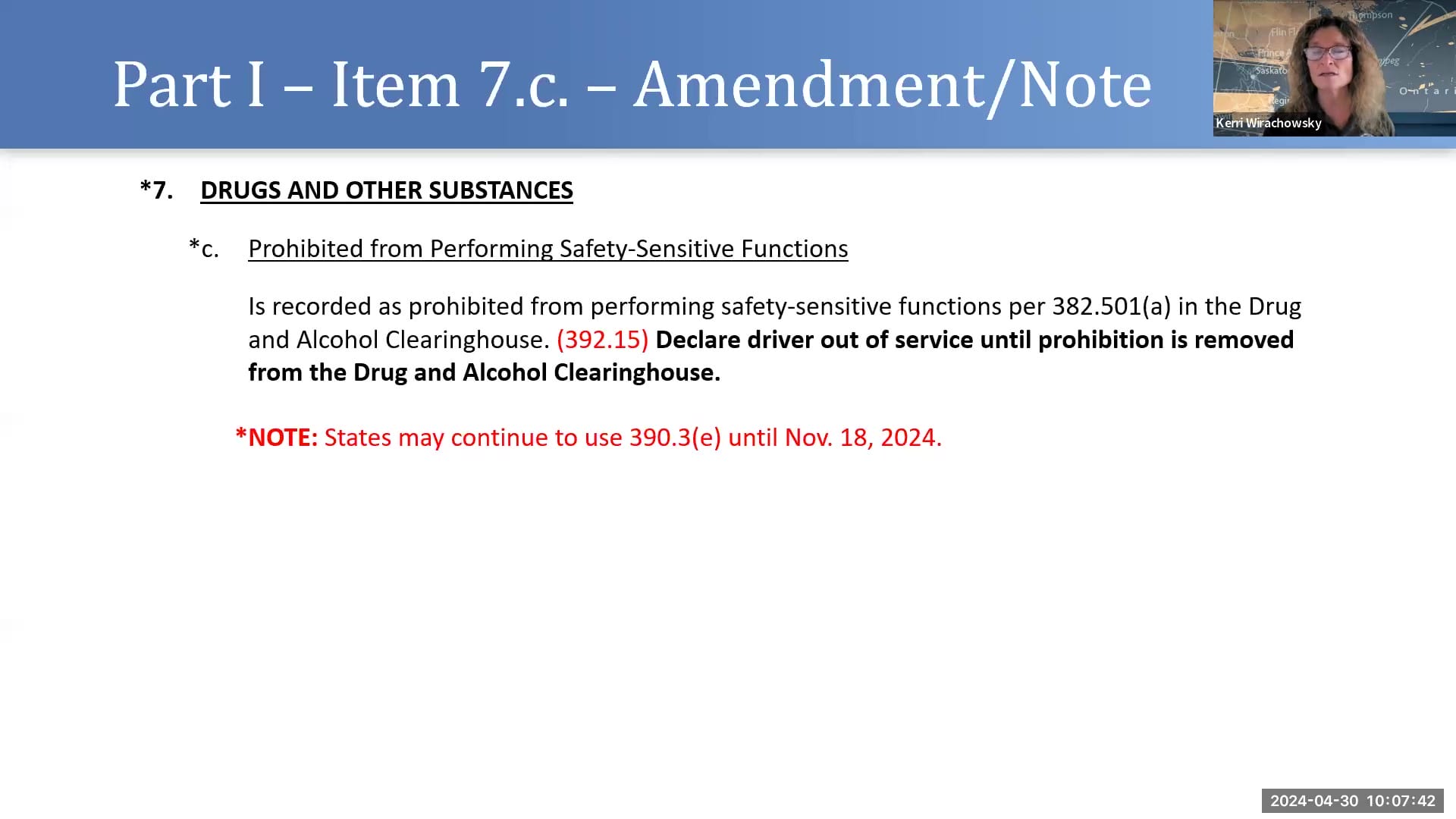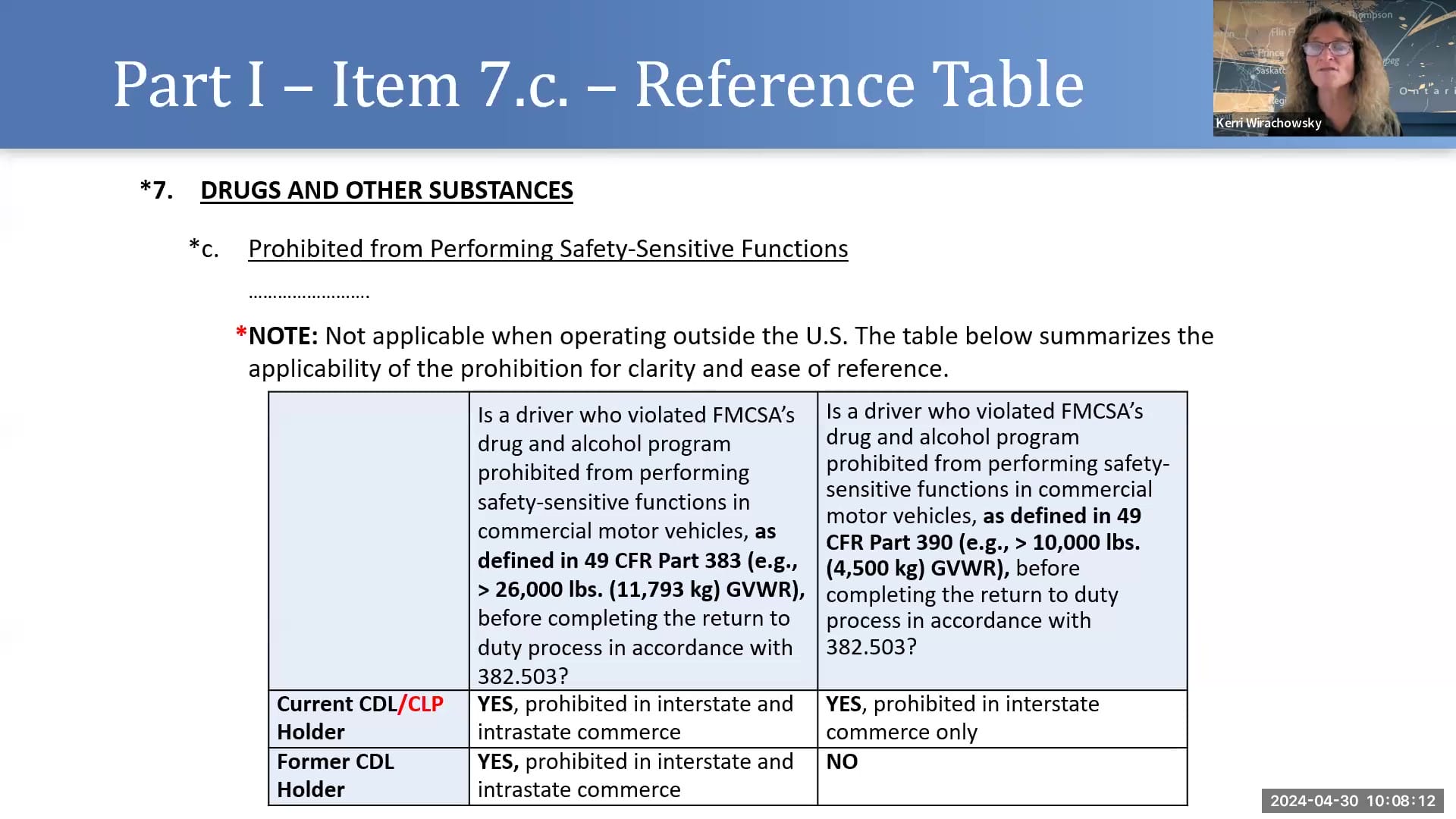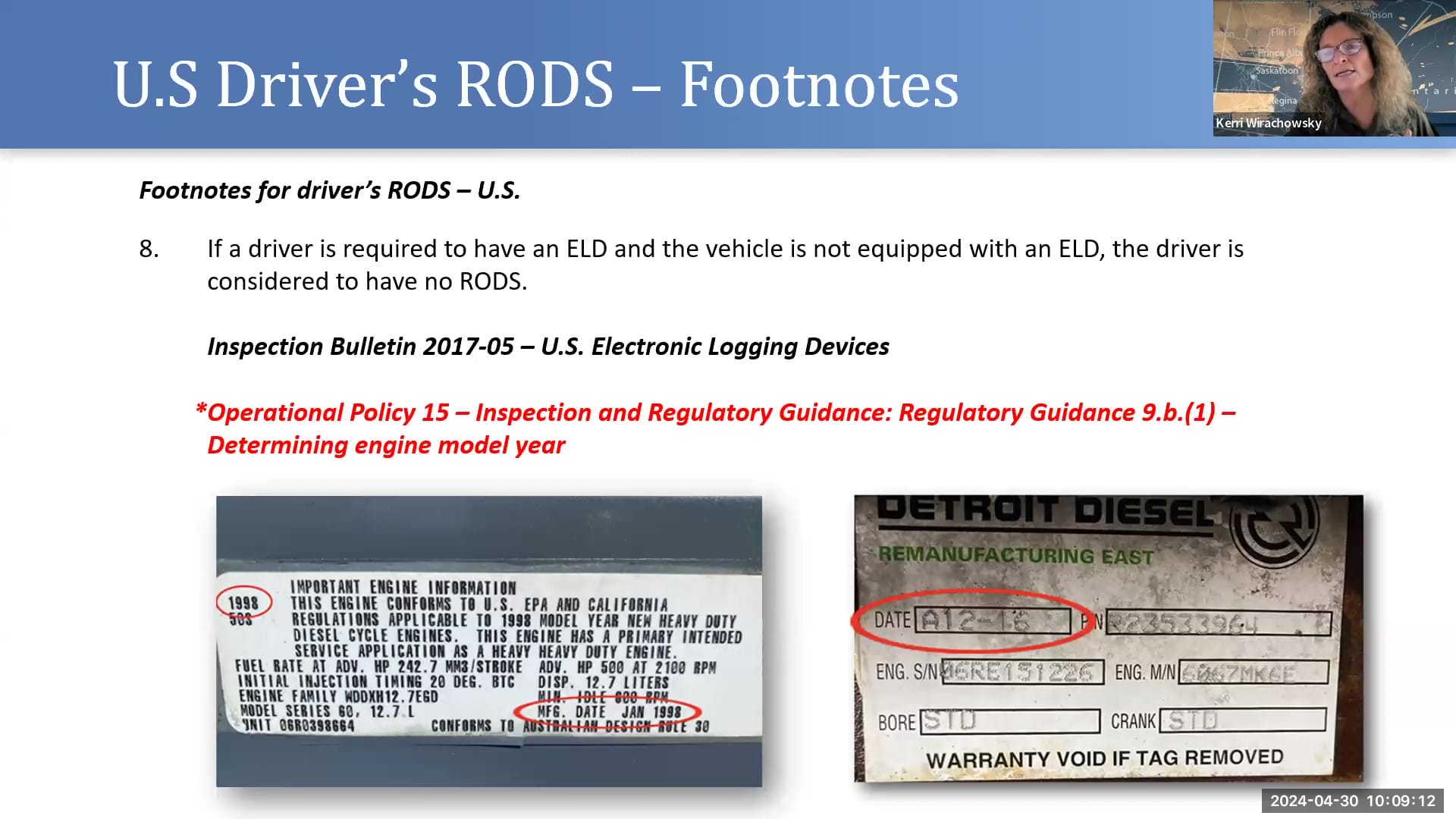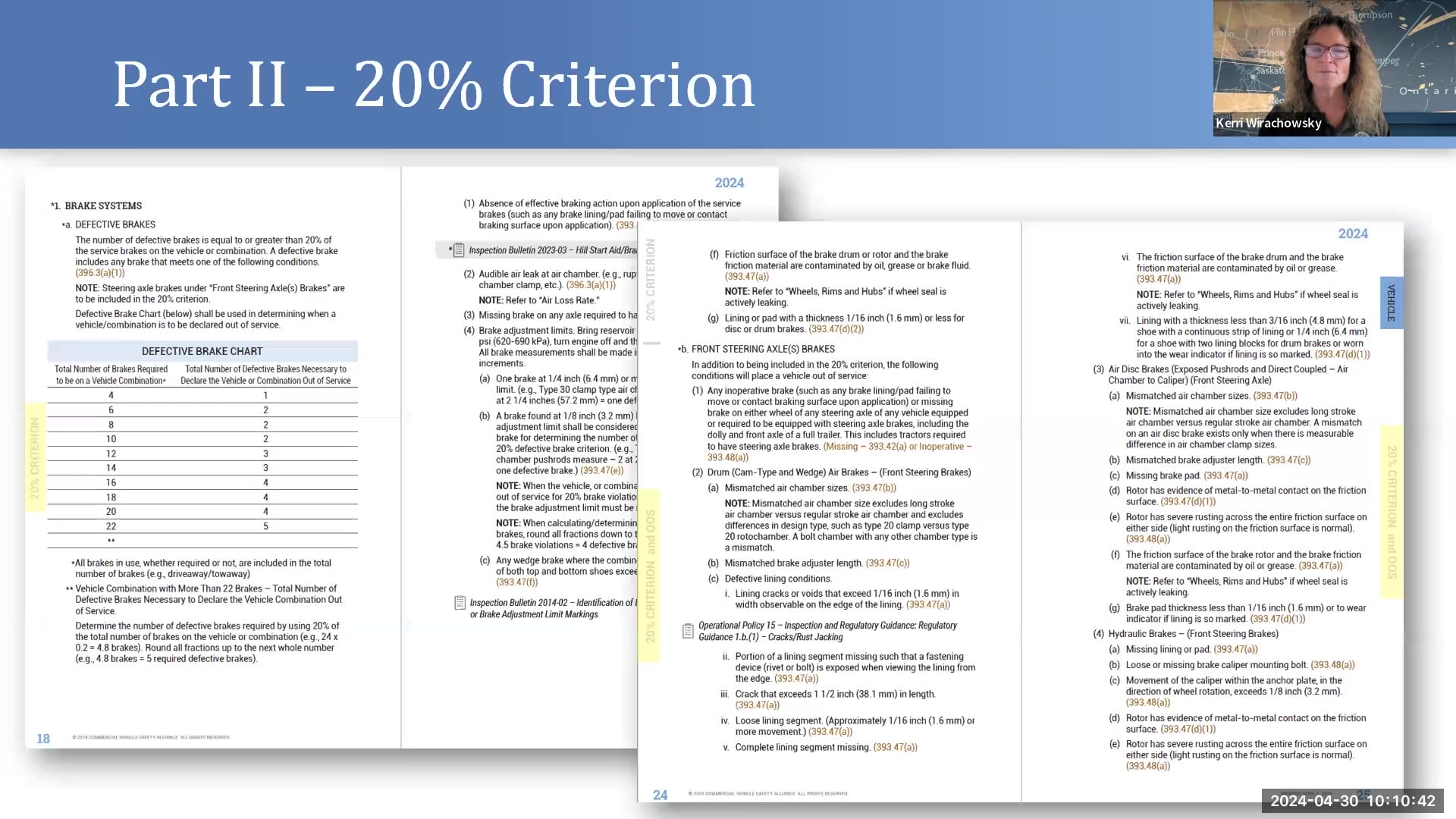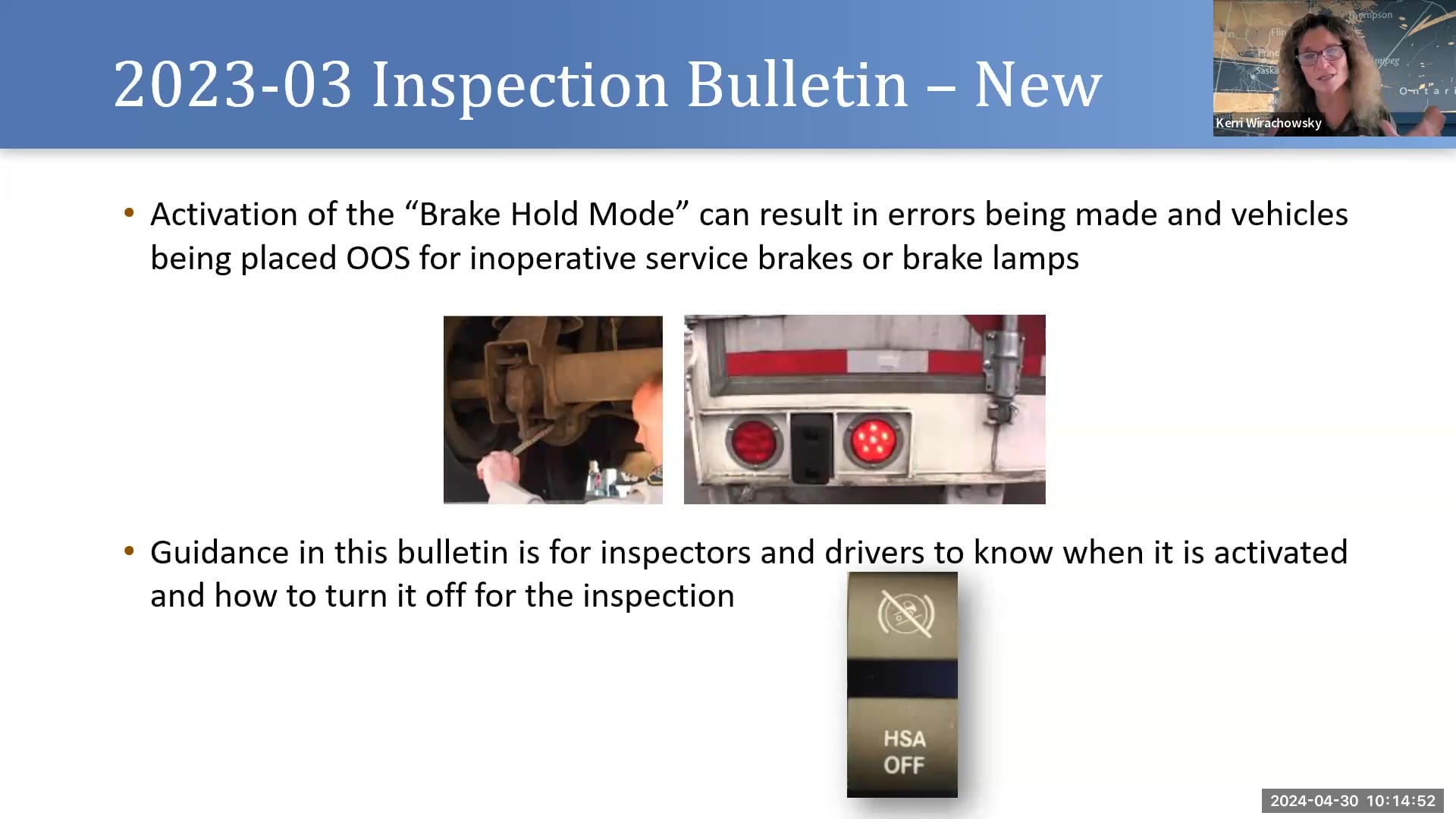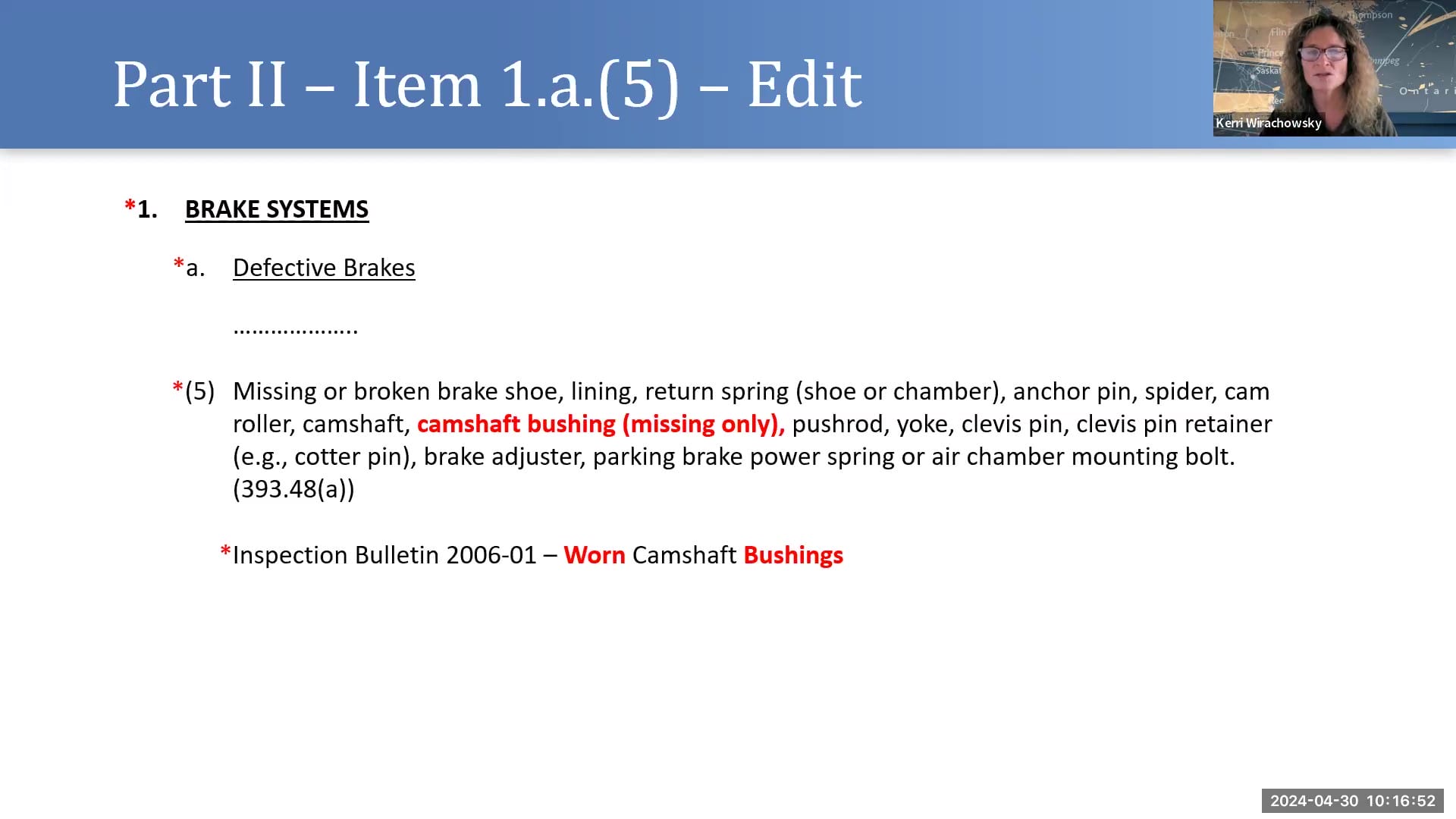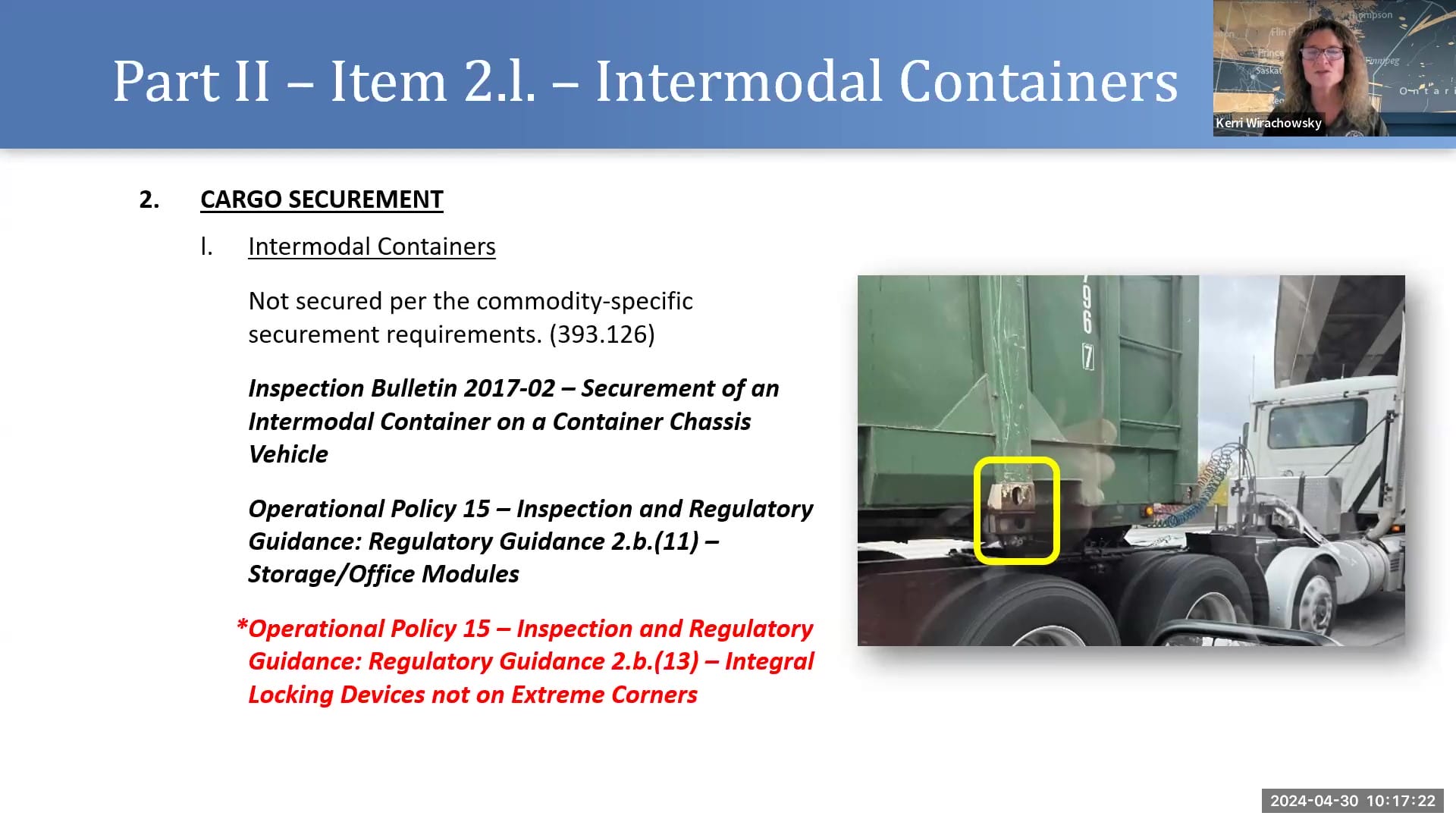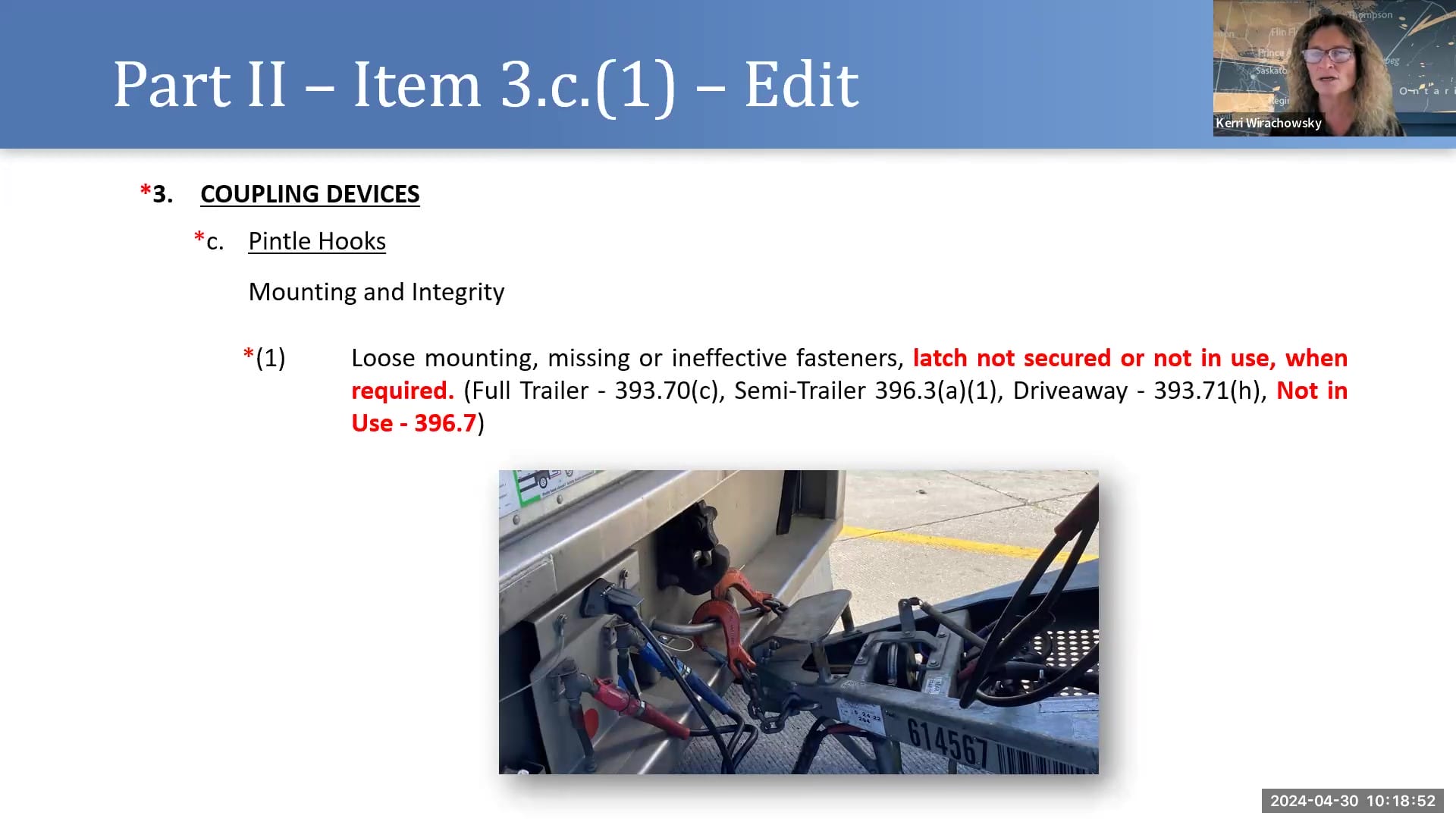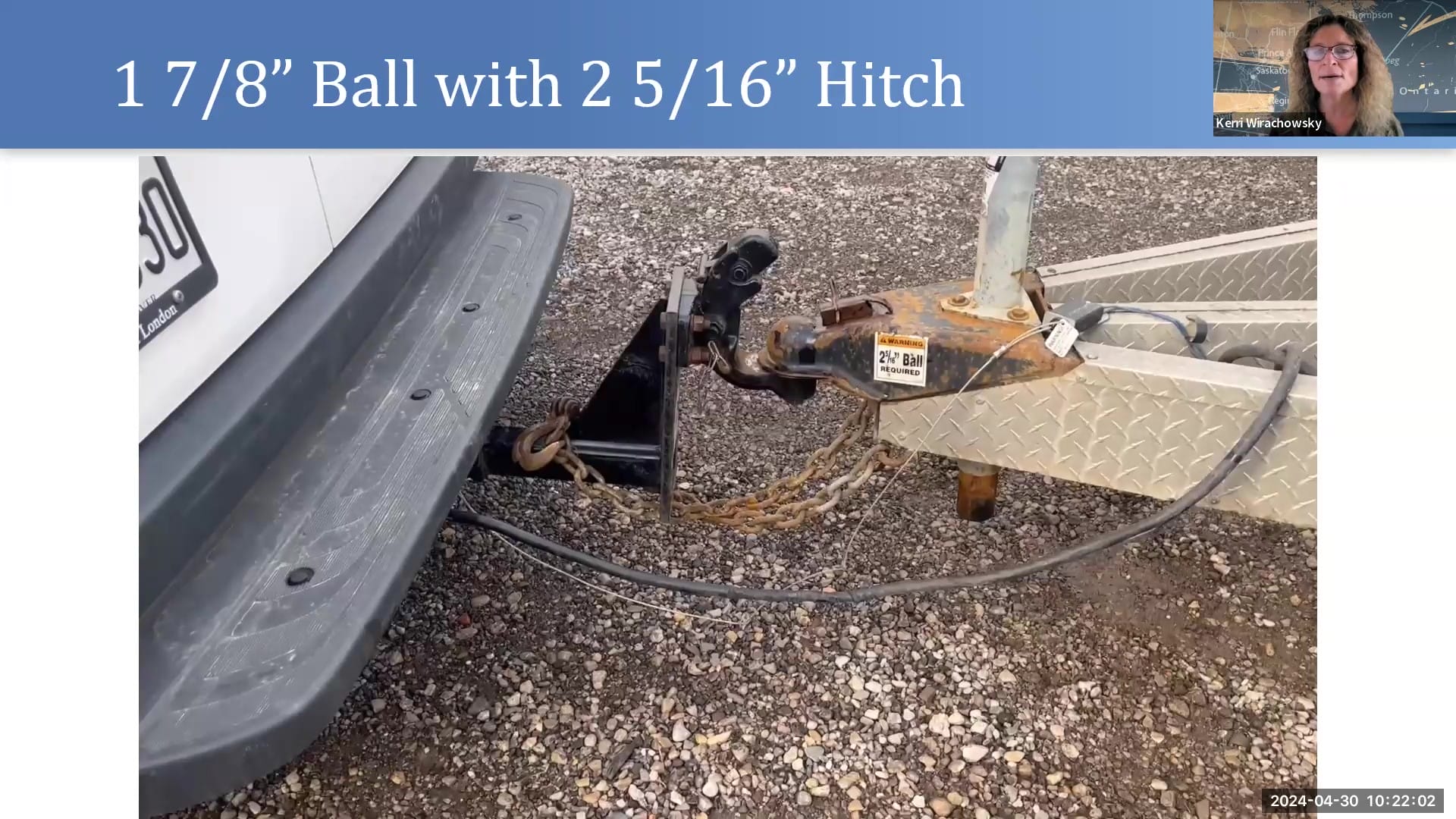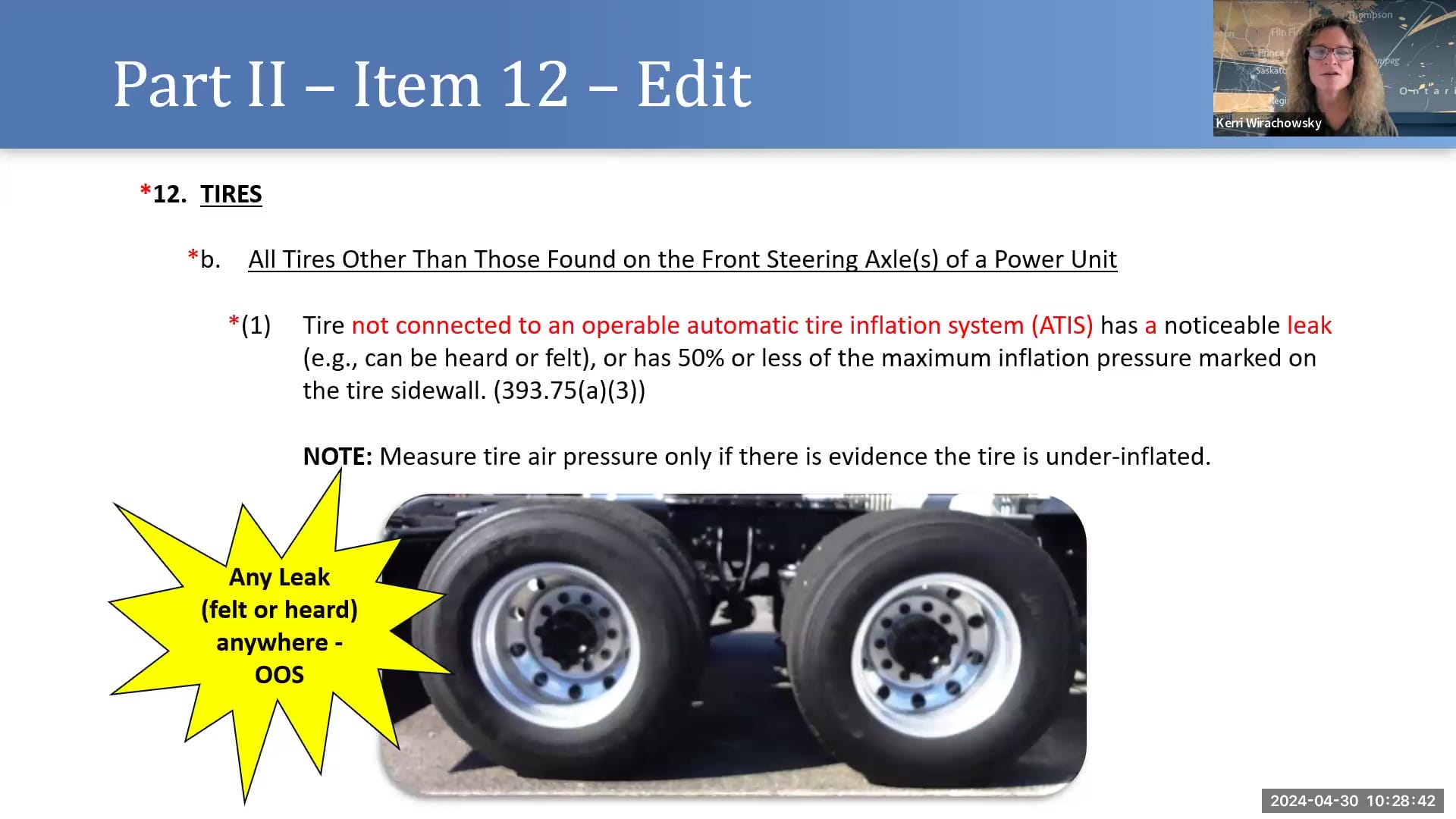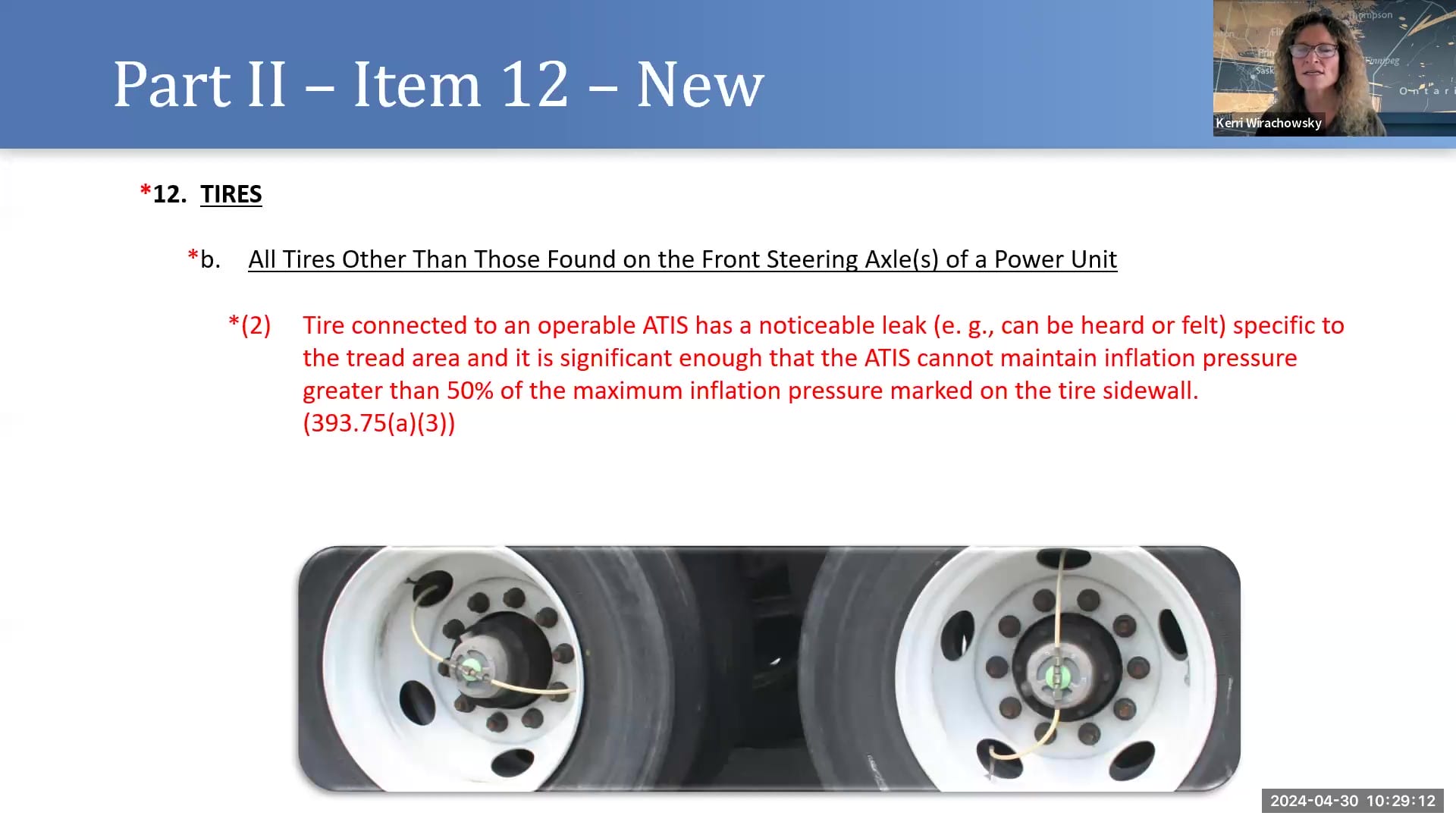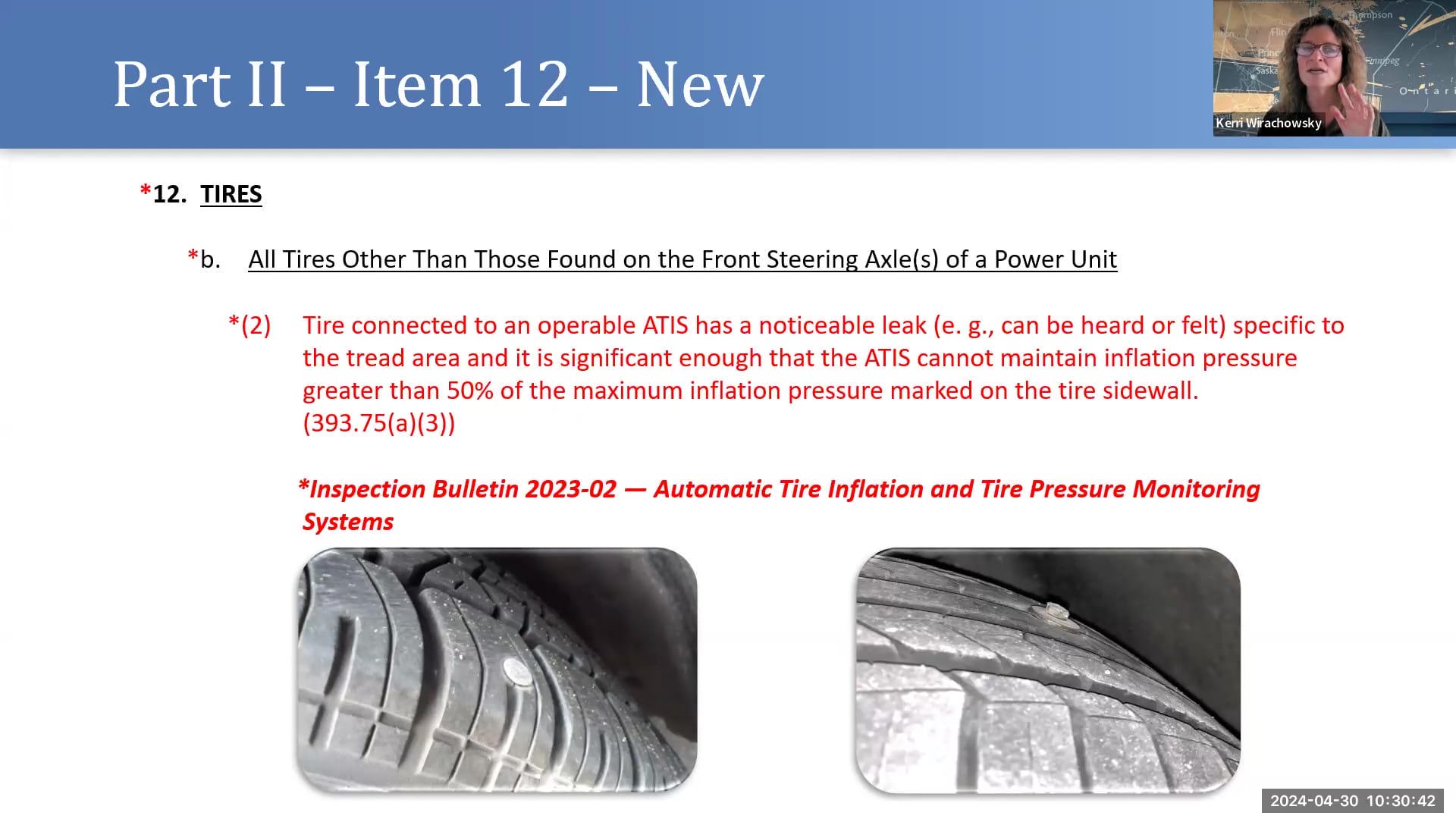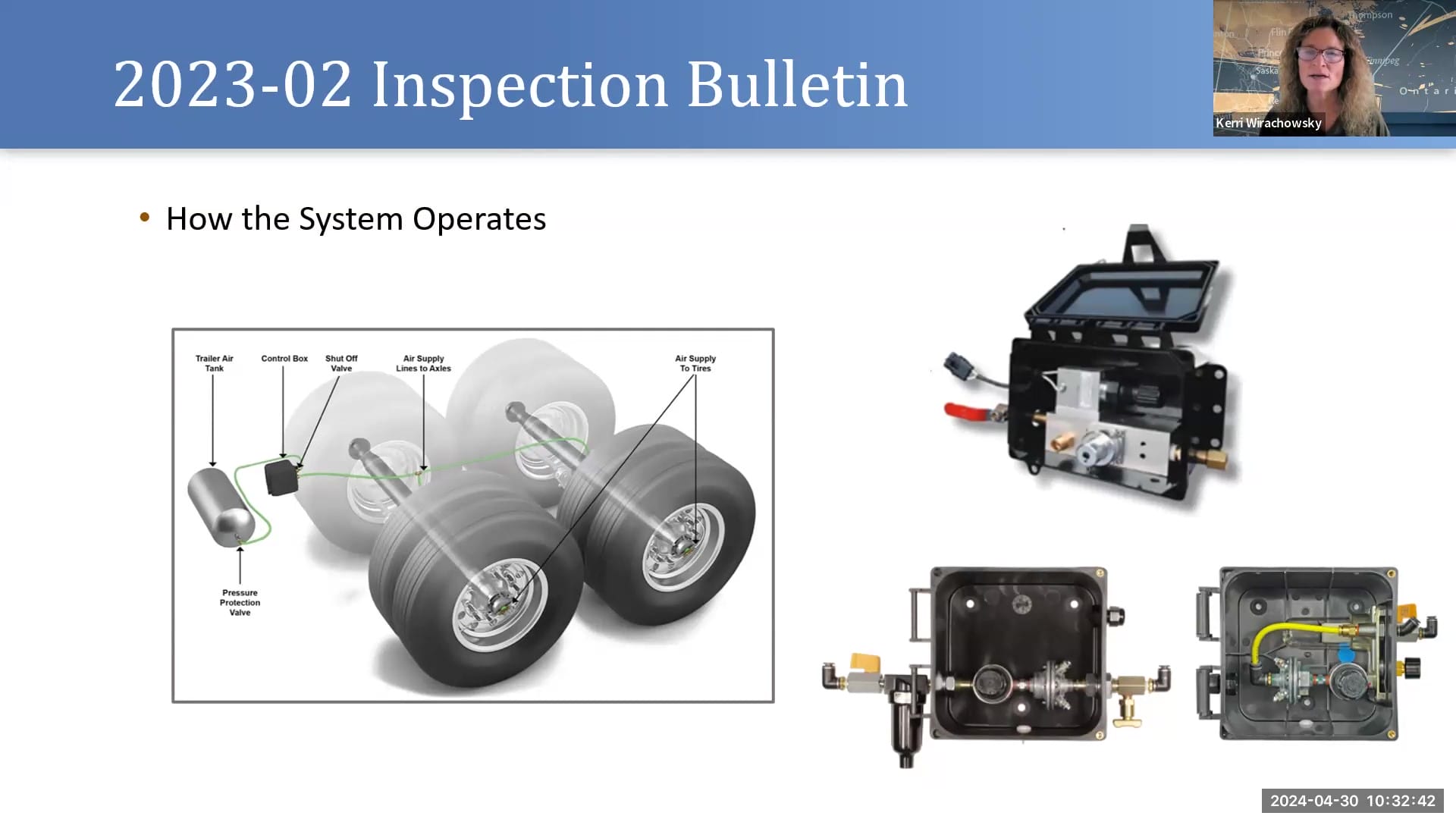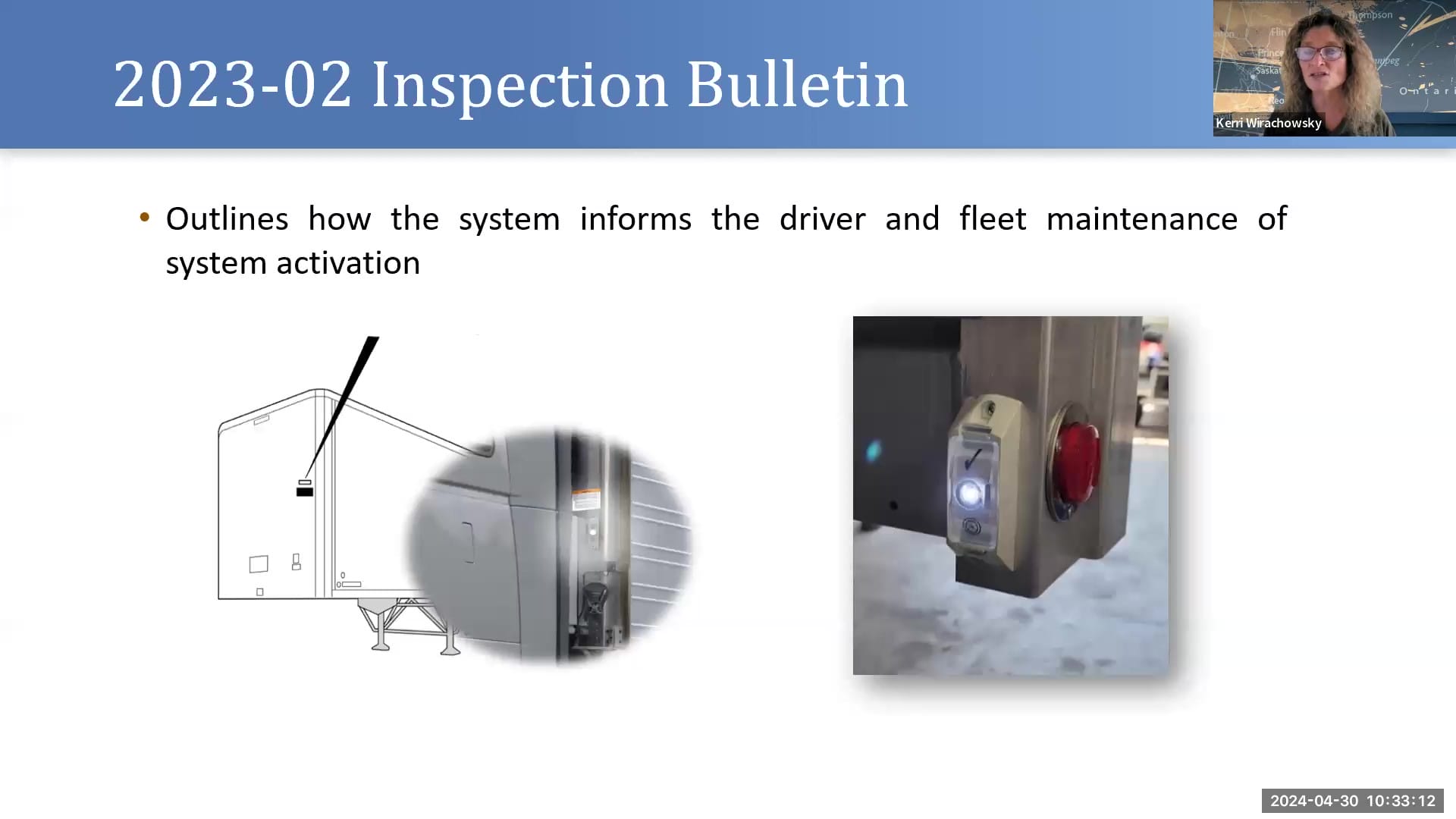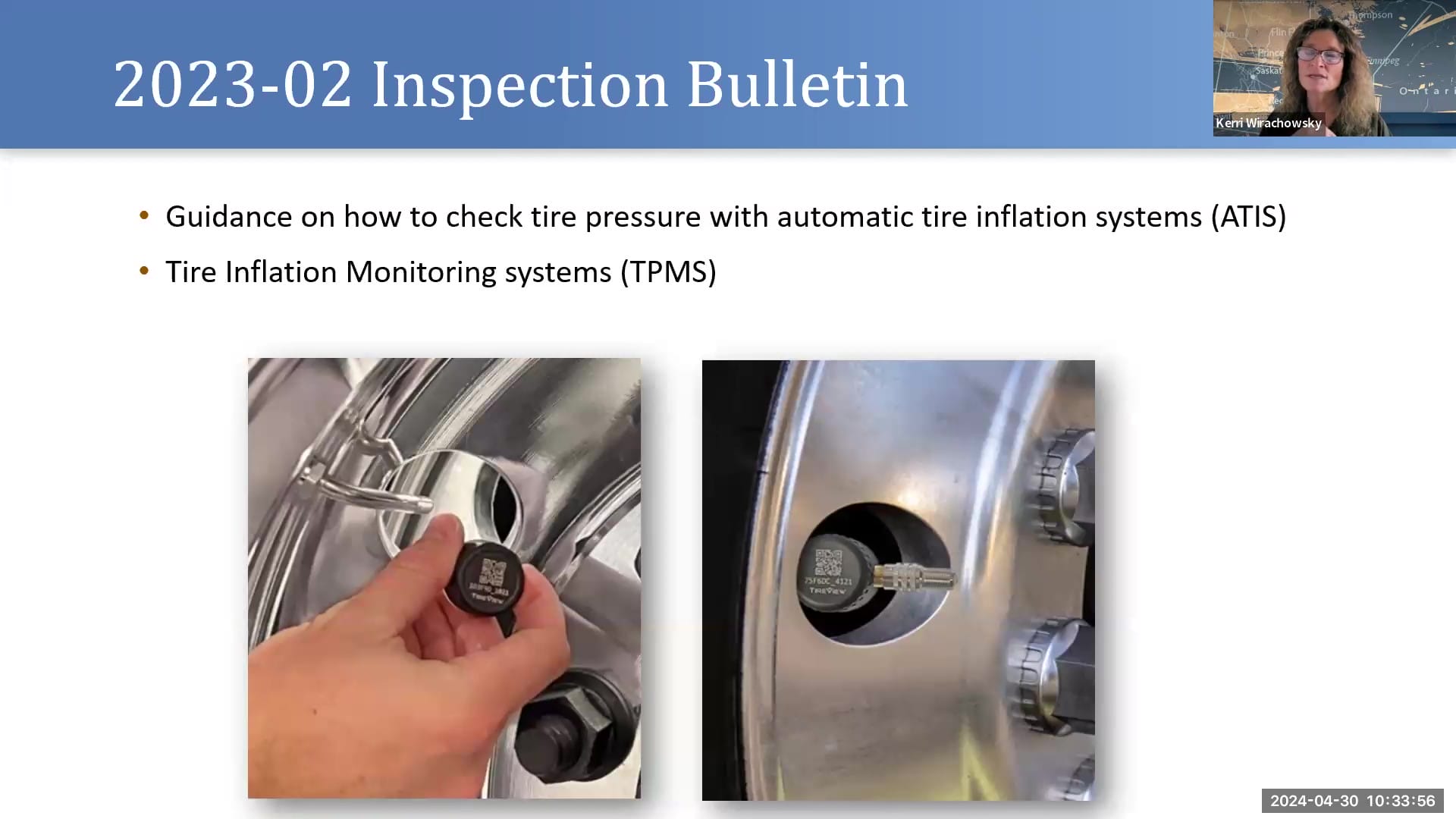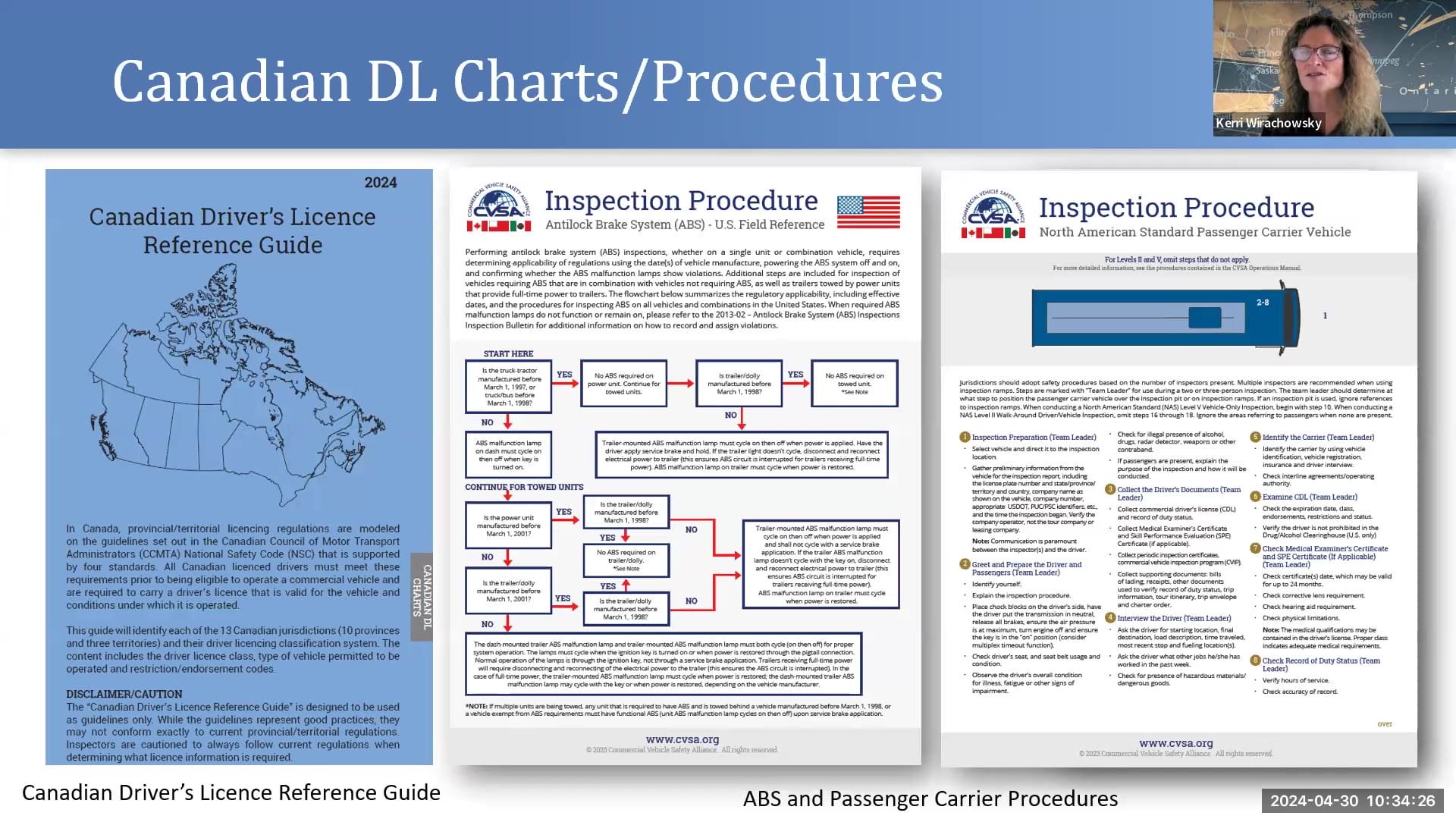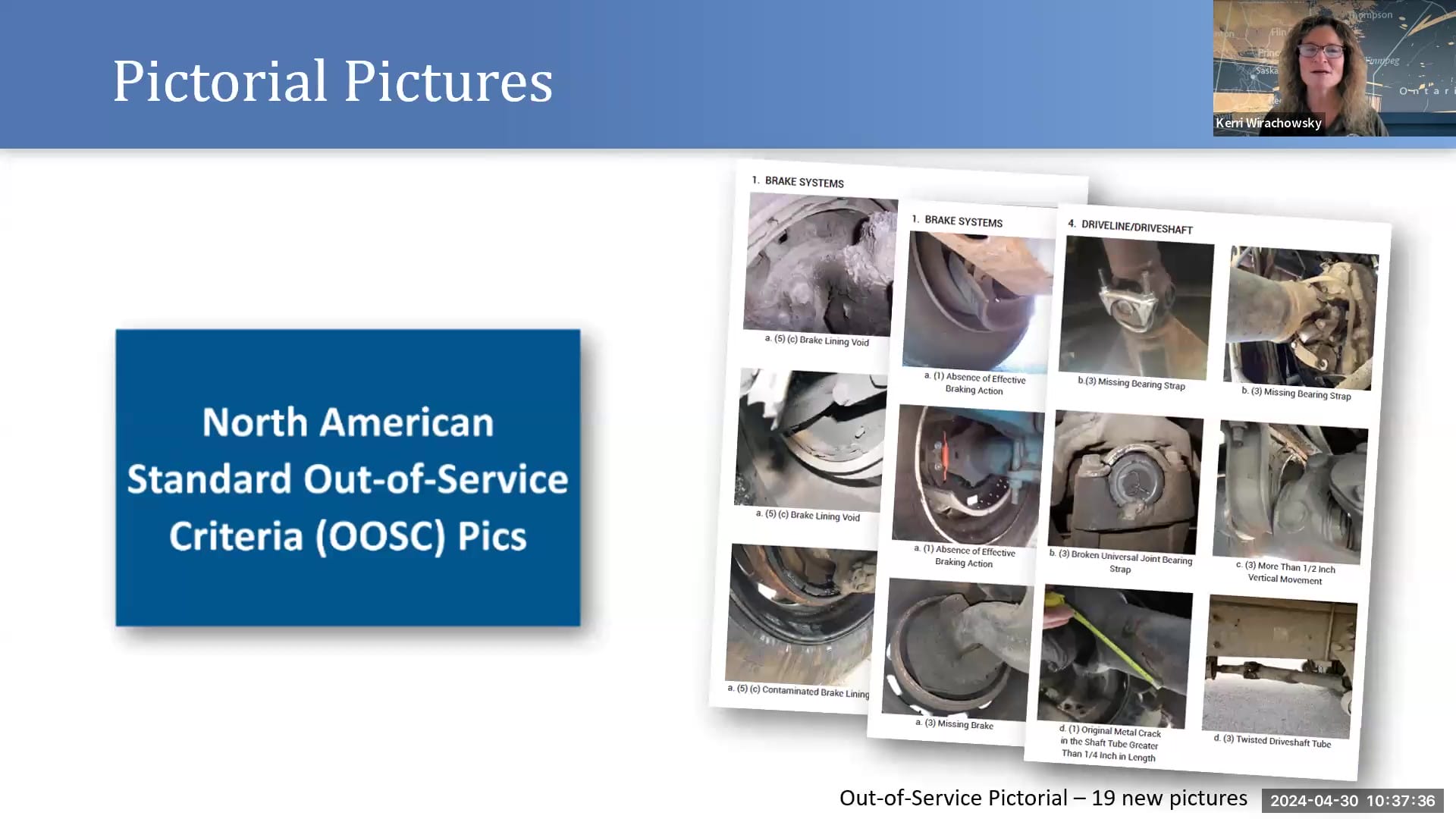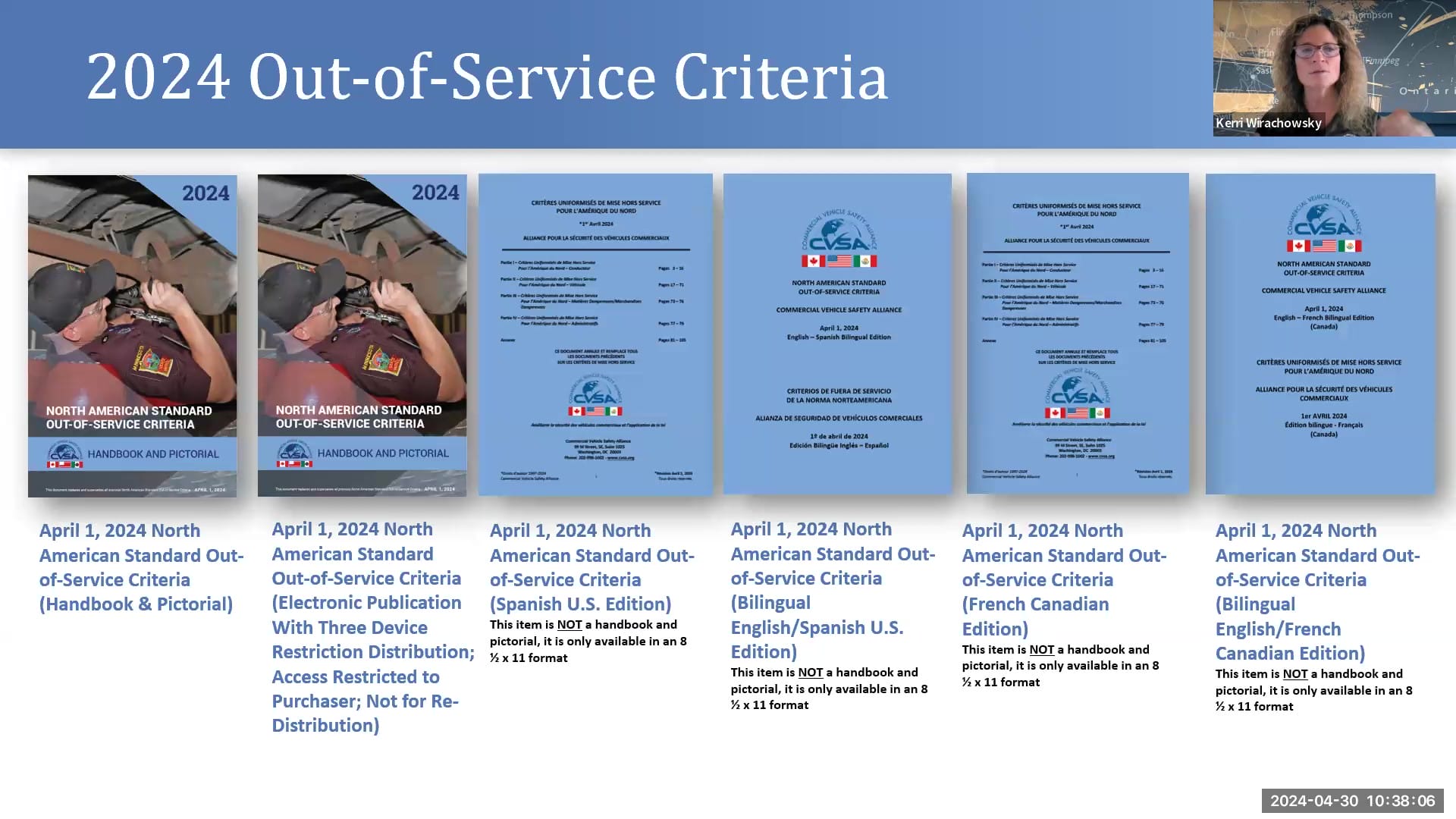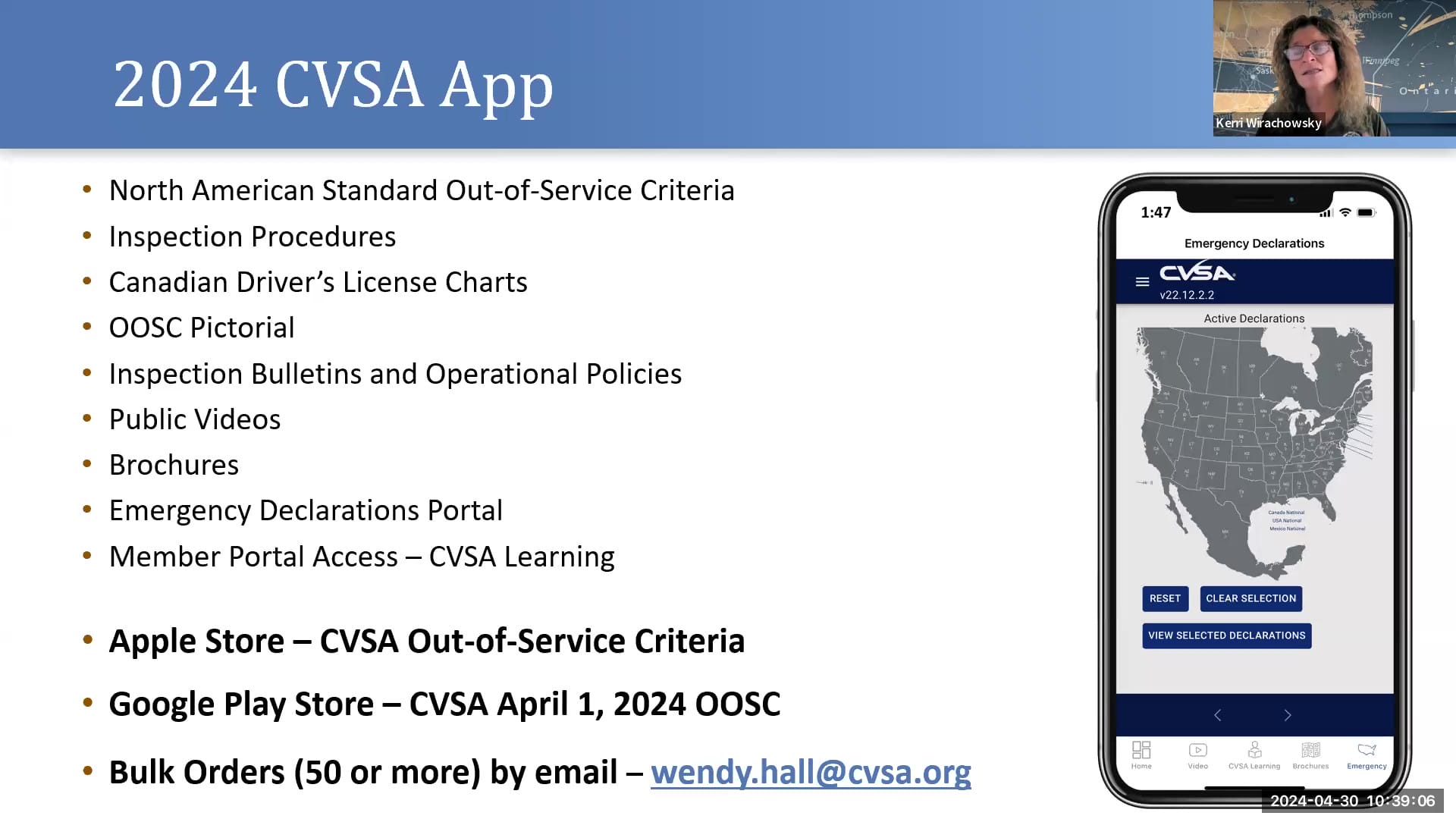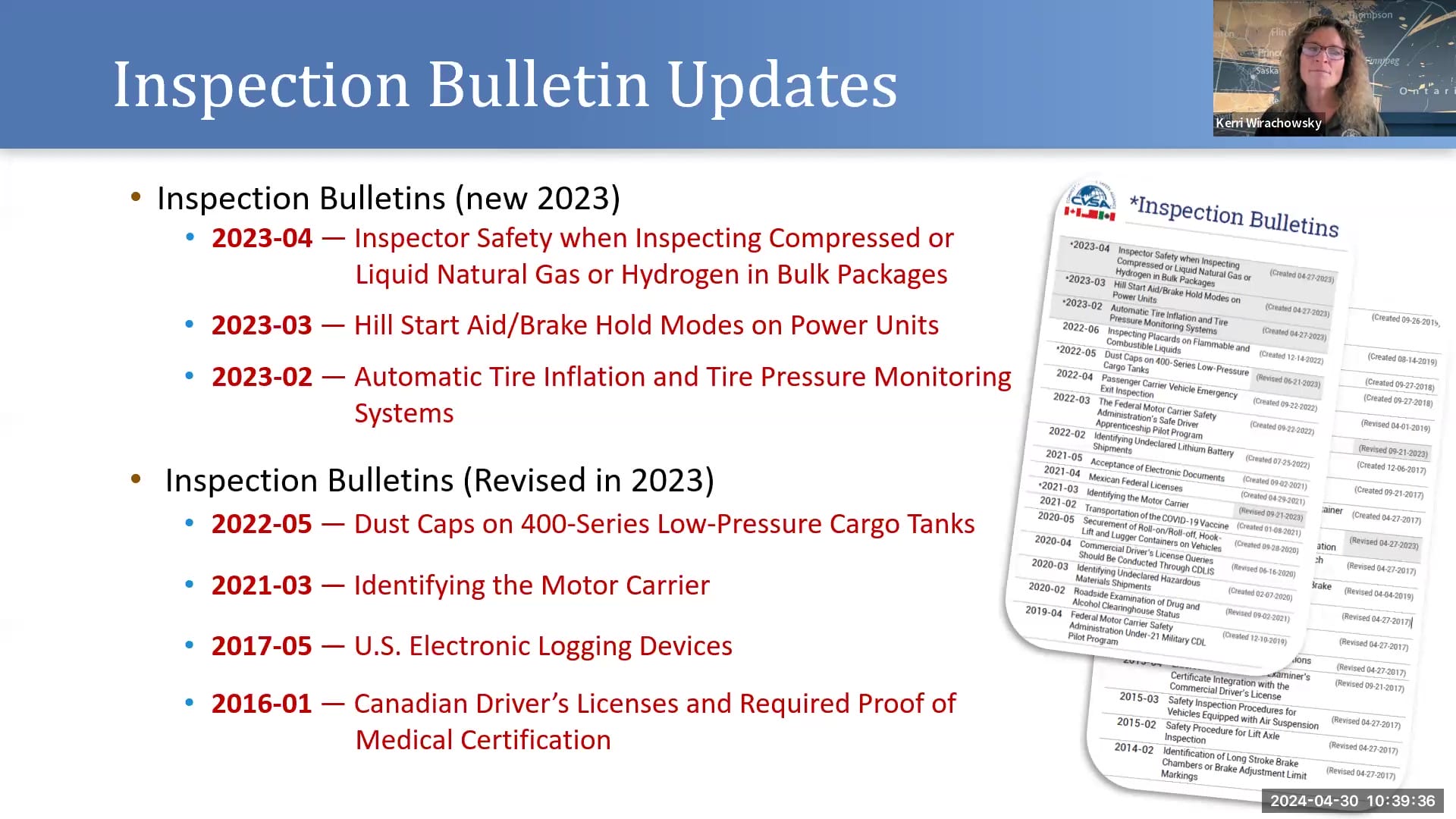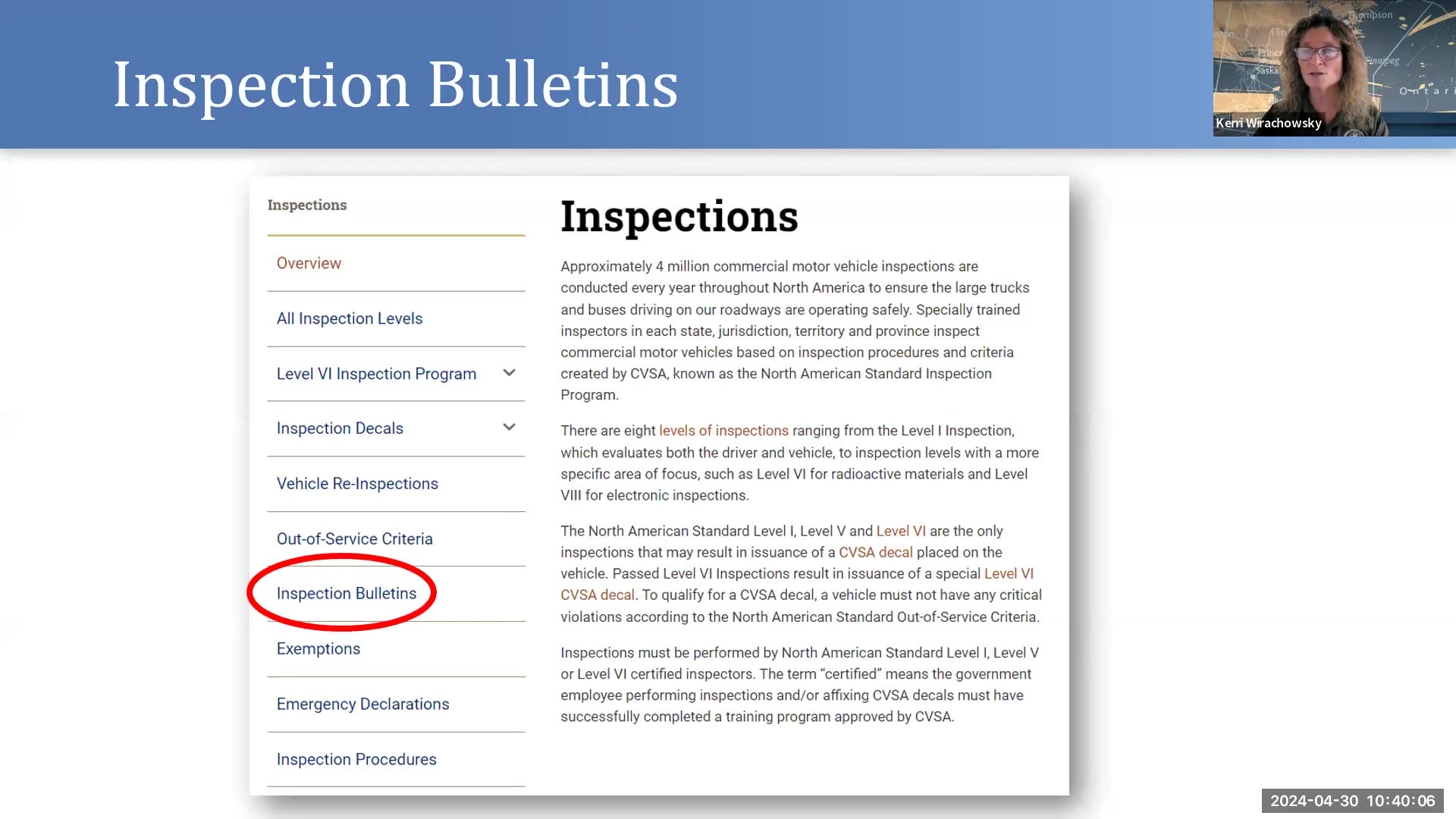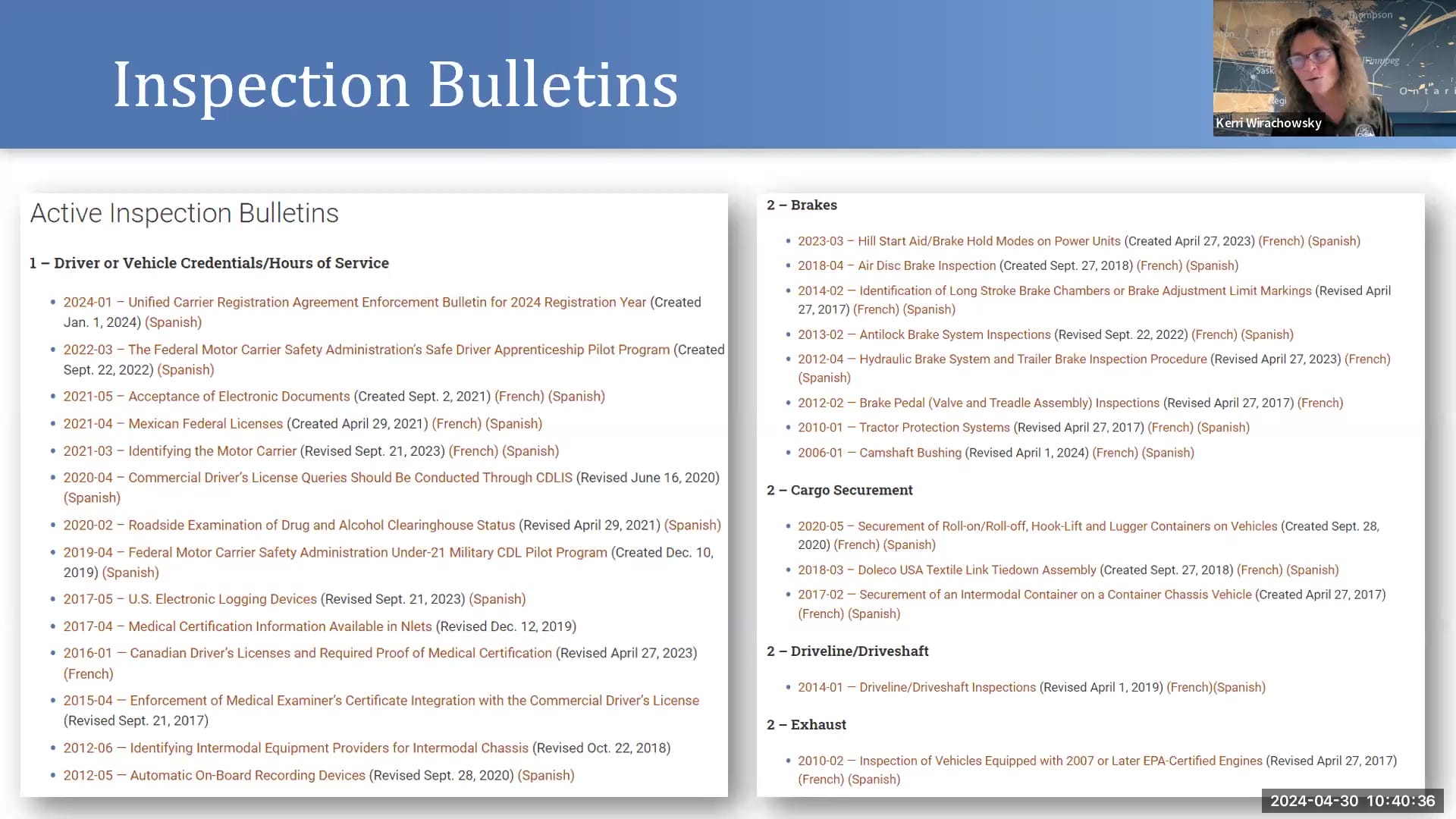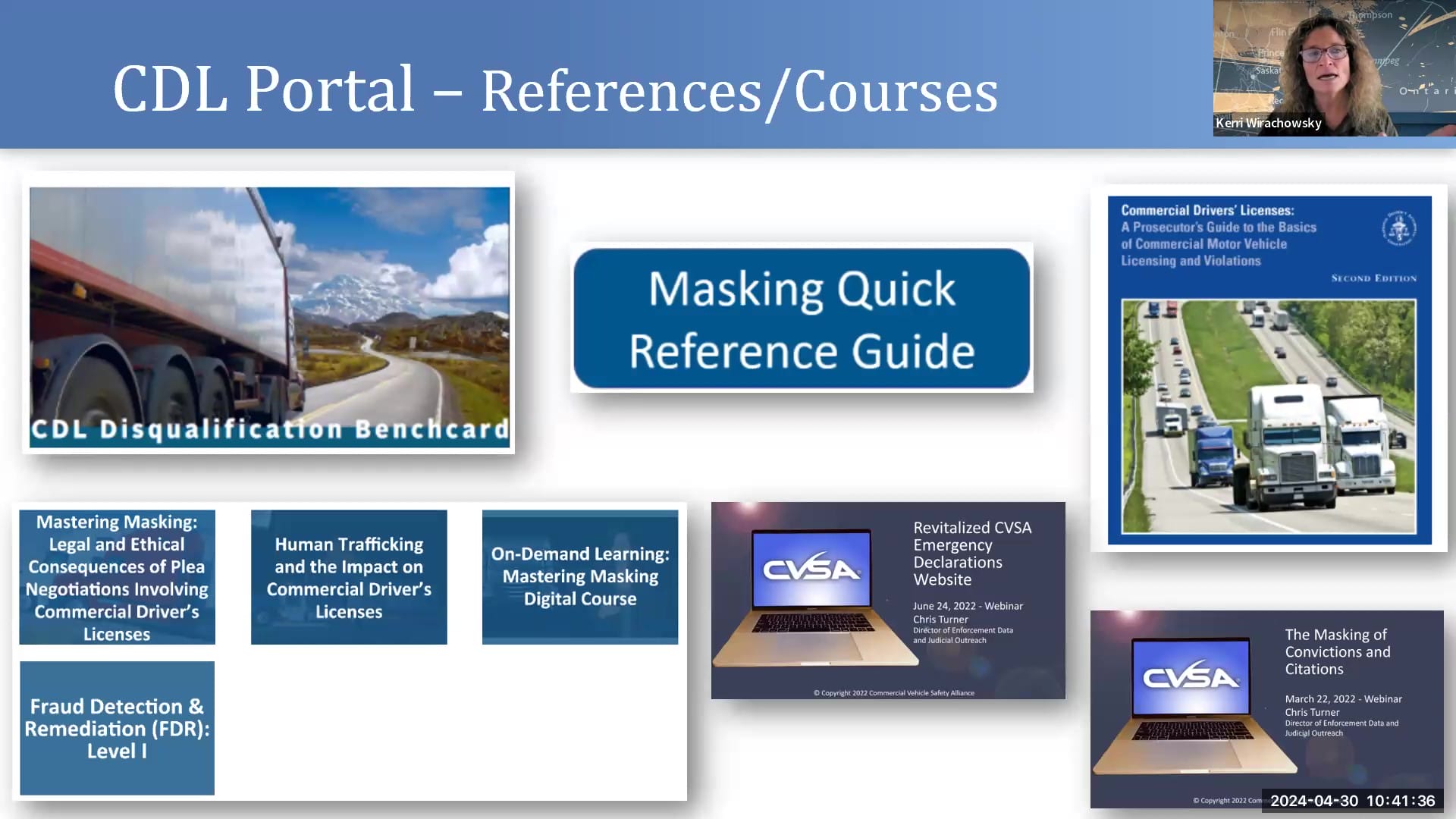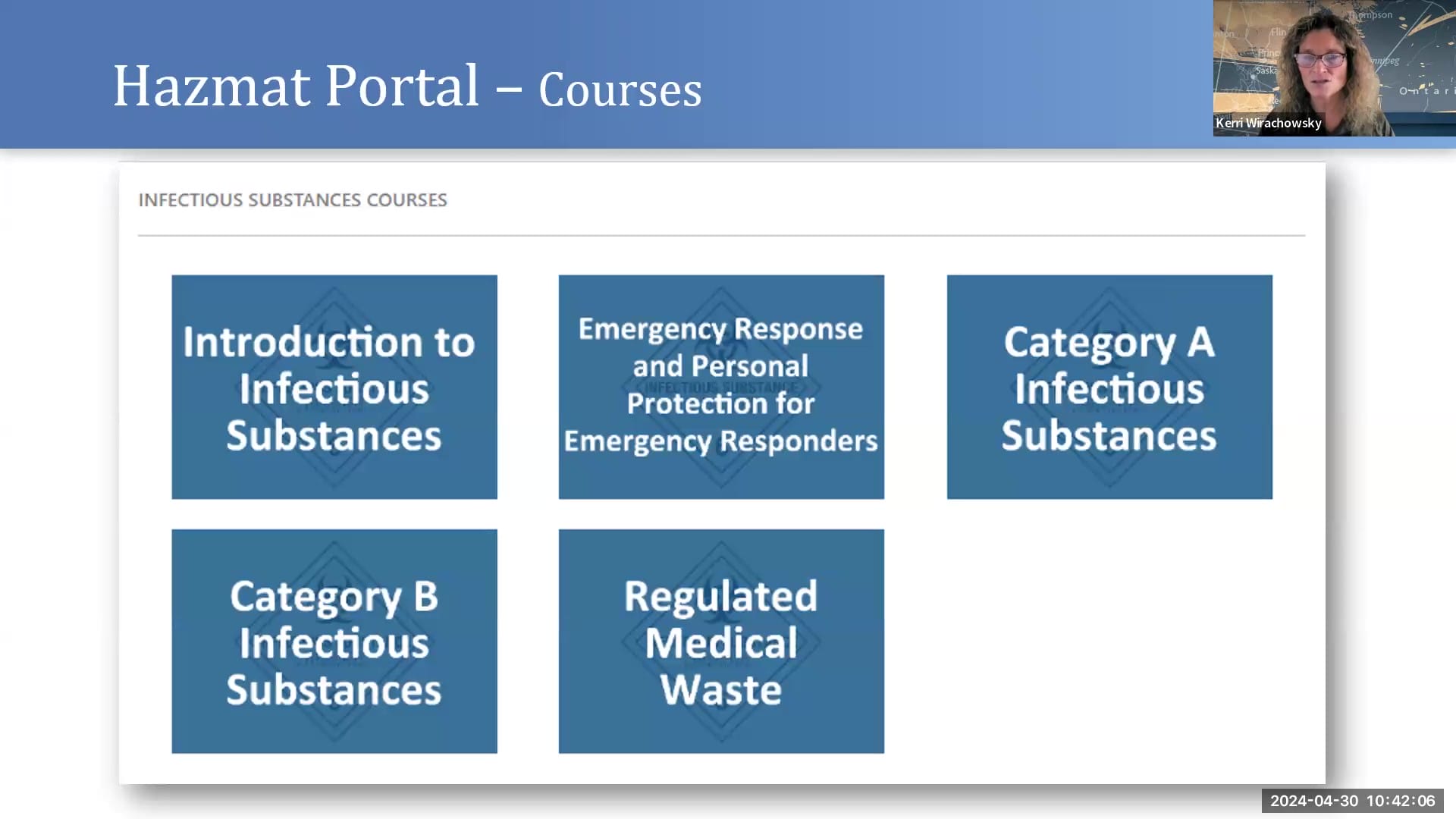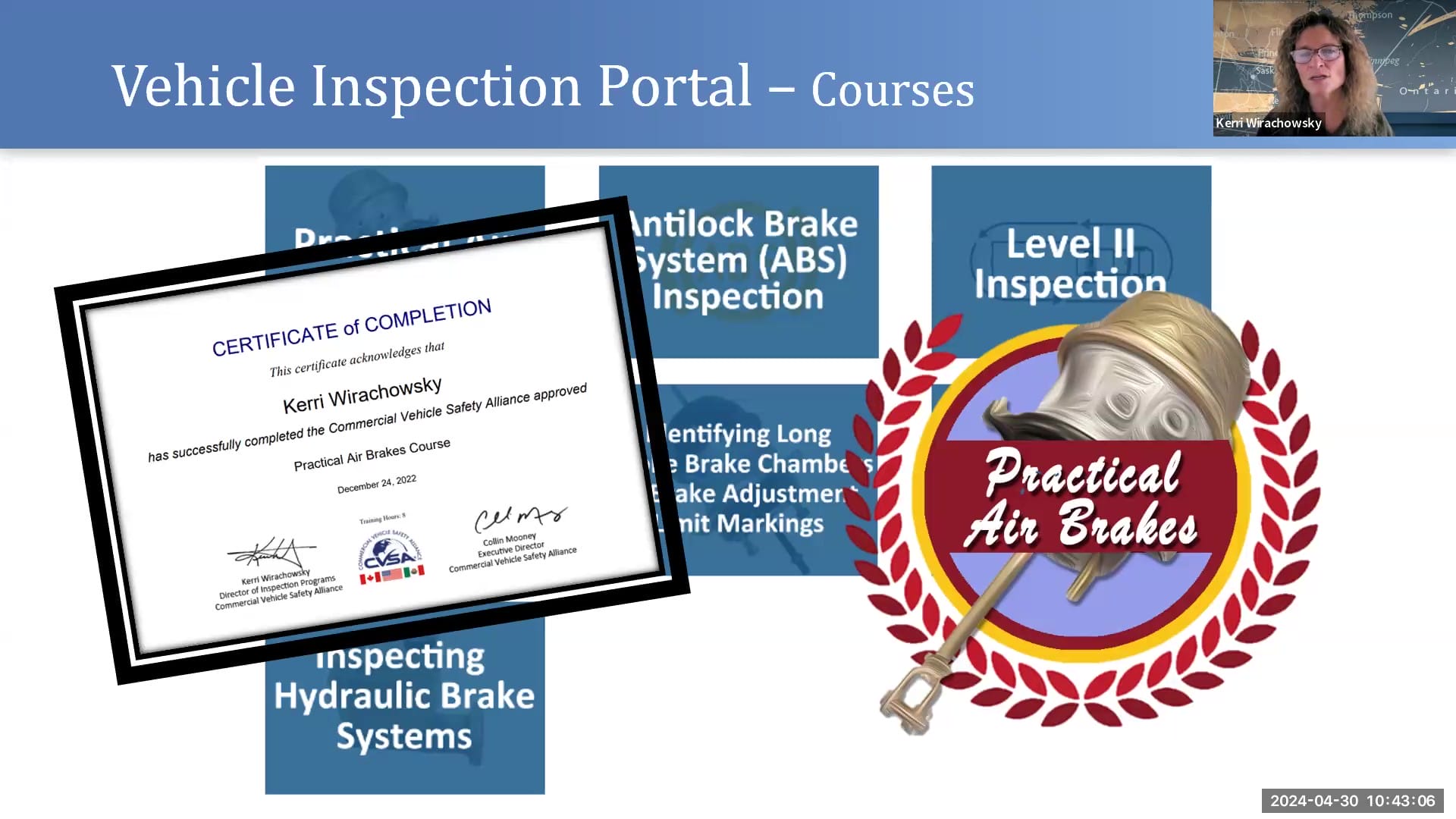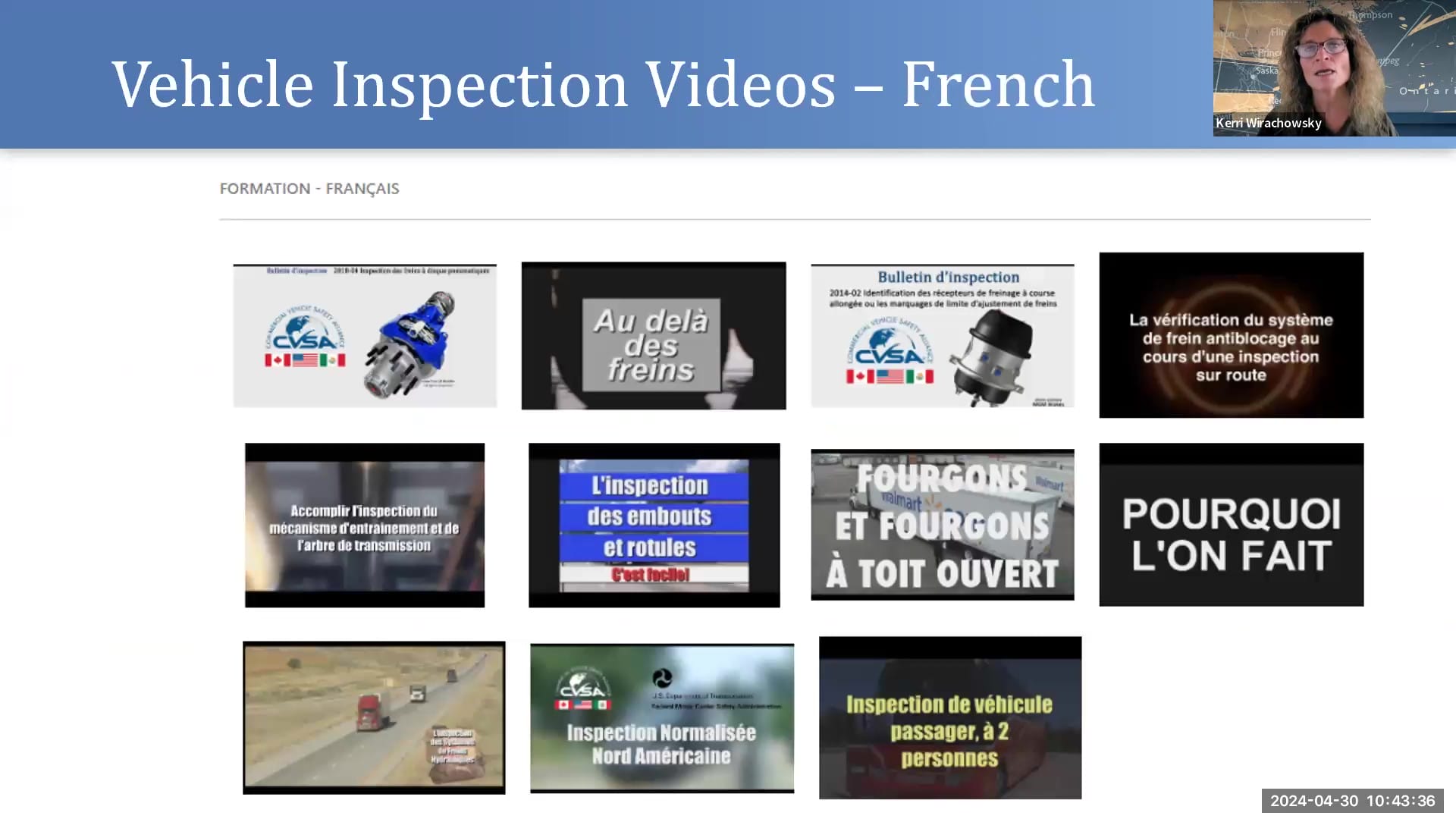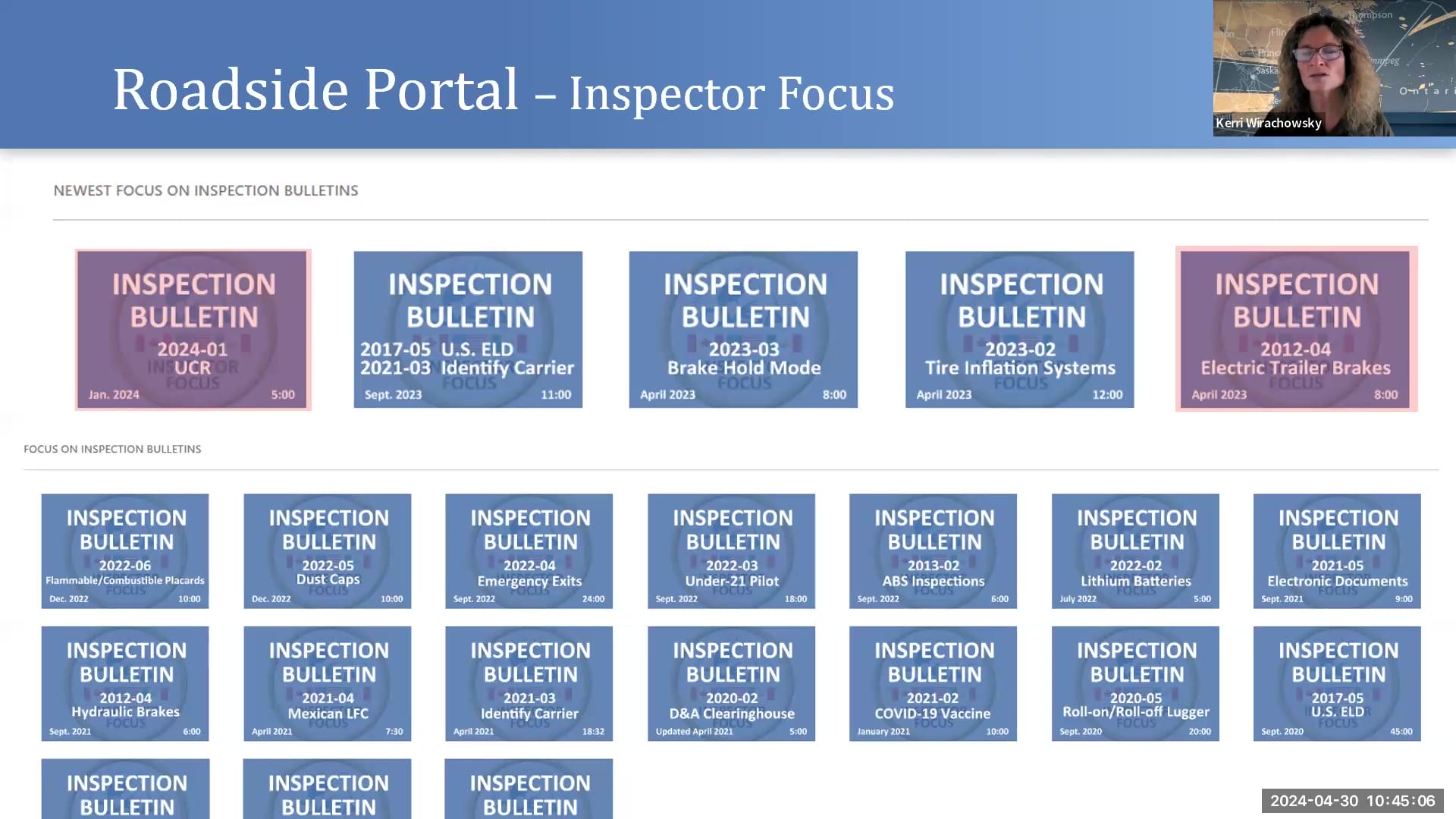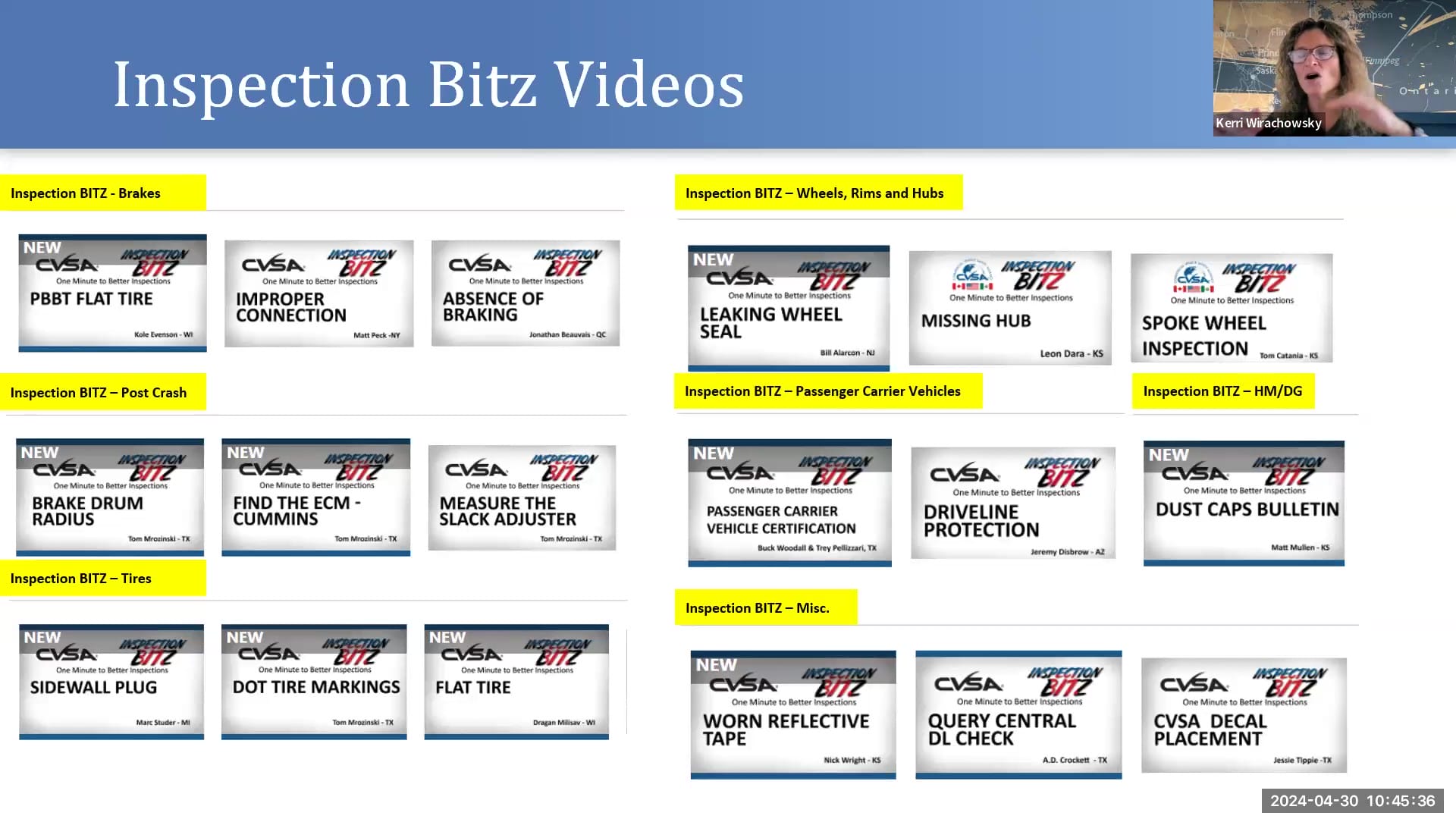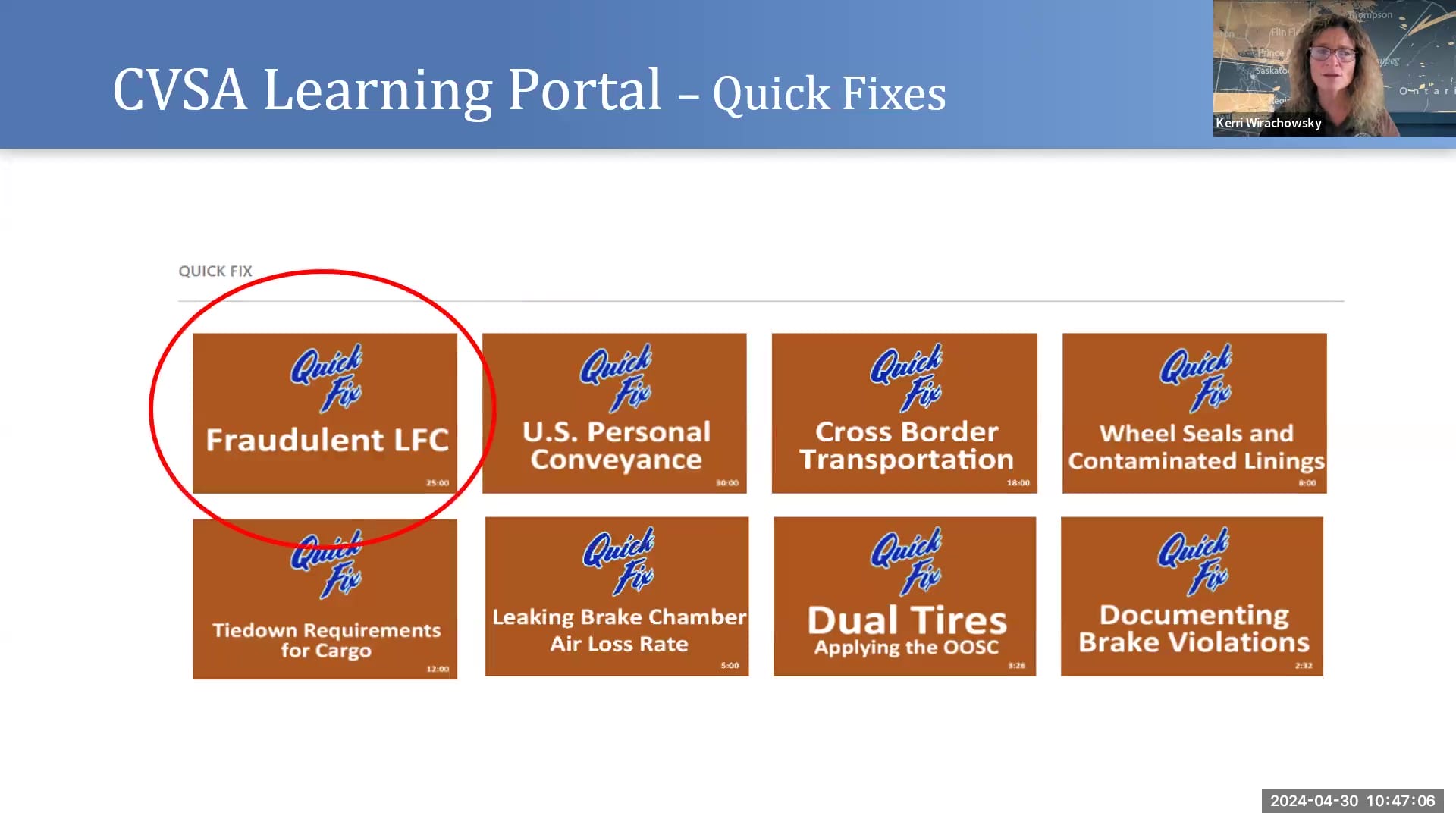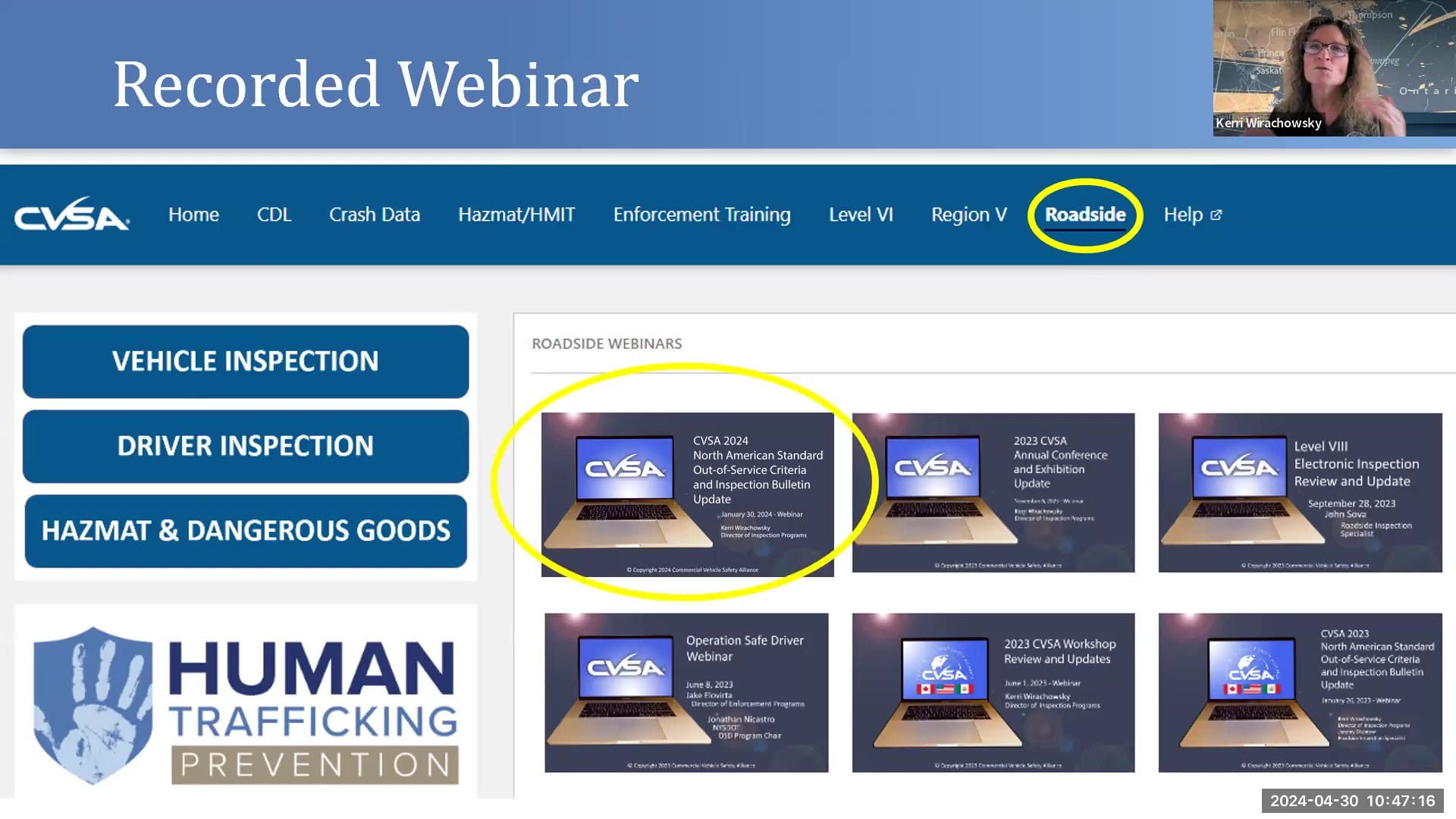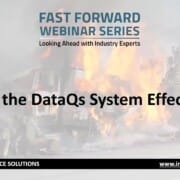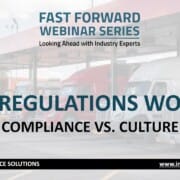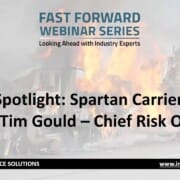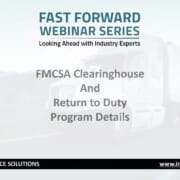Transcription
1
00:00:04.350 –> 00:00:10.902
Steve Kessler: Good morning, everybody welcome to the Infinit-I Workforce Solutions Fast Forward Webinar Series.
2
00:00:12.384 –> 00:00:16.920
Steve Kessler: My name is Steve Kessler, and I’ll be the host for the program today.
3
00:00:17.316 –> 00:00:33.340
Steve Kessler: We’ve got an important topic to talk about today, we’re going to talk about the 2024 North American Standard Out of Service. We’re going to kind of go through a review. Believe there were some recent updates that became effective on the first of April.
4
00:00:33.870 –> 00:00:37.379
Steve Kessler: So, we have a representative from CVSA that’s going to
5
00:00:38.100 –> 00:00:43.509
Steve Kessler: talk about those updates and maybe review some of the updates from last year.
6
00:00:44.035 –> 00:01:04.059
Steve Kessler: I’m also joined today by Mark Rhea, those of you that come on our webinars often will know Mark. Mark’s an industry executive for what? 34-35 years, now Mark or something like that. So, we are always glad to have Mark on board with us.
7
00:01:04.129 –> 00:01:28.929
Steve Kessler: A couple of housekeeping items before we get started. Everyone is muted that has joined the webinar. So, we can’t hear you. If you need to, or want to ask a question, you can type that into the little chat box that’s there, or you can use the Q & A. Box, and we will try to respond to those questions at the end of the presentation.
8
00:01:29.150 –> 00:01:33.230
Steve Kessler: So, mark any comments where we get started, and I introduce our guest.
9
00:01:33.230 –> 00:01:44.389
Mark Rhea: No, I think we’re absolutely privileged to have Kerri with us today from CVSA. For you guys and gals that don’t know, is the absolute authority
10
00:01:44.720 –> 00:01:59.189
Mark Rhea: on Out of Service, criteria, and violations. They take their input from both industry and enforcement. They’re not sitting in a high rise in downtown Chicago, making things up. They listen to the
11
00:01:59.240 –> 00:02:12.399
Mark Rhea: to the industry and the enforcement to make our highways safer. So, I’m really looking forward to the updates and I would also say, this is a great opportunity to add a little custom content for your drivers, because they need to know
12
00:02:12.828 –> 00:02:15.200
Mark Rhea: what’s going on out there in the
13
00:02:15.280 –> 00:02:17.180
Mark Rhea: enforcement world.
14
00:02:18.320 –> 00:02:33.480
Steve Kessler: Great thanks, Mark. So, without any further delay, let me introduce you to all to our guest today. Our guest today is Kerri Wirachowsky. Carrie is currently the director of inspection programs at CVSA.
15
00:02:34.358 –> 00:02:50.711
Steve Kessler: Kerri ‘s Transportation safety career started in 1987, when she joined the Ontario Ministry of Transportation, she advanced through the ranks there, starting as an administrative assistant worked away up to head of Enforcement program,
16
00:02:51.547 –> 00:02:54.890
Steve Kessler: evaluation with the Carrier Safety and Enforcement Branch.
17
00:02:55.748 –> 00:03:08.699
Steve Kessler: Prior to joining CVSA. Staff in 2017, Kerri served as CVSA’s Vehicle Committee chair for 10 years Co. Chair The North American Ex Inspectors Championship
18
00:03:08.750 –> 00:03:12.890
Steve Kessler: for 4 years, and as a region 5 president for one year.
19
00:03:12.980 –> 00:03:26.979
Steve Kessler: Kerri is a former CVSA level 1 and Level 6 inspector and North American Standard Instructor developer, and she is the 2001 NEIC Jimmy K. Eman’s grand champion.
20
00:03:27.270 –> 00:03:32.760
Steve Kessler: So, without any further delay. Welcome, Kerri! Thanks for joining us this morning.
21
00:03:32.920 –> 00:03:33.930
Kerri Wirachowsky: Thanks, Steve.
22
00:03:34.820 –> 00:03:45.060
Kerri Wirachowsky: Got a lot to cover today. But I will tell you. The most of what I’m going to cover is any changes to the 2024 North American Standard Out of Service Criteria.
23
00:03:46.220 –> 00:03:51.119
Kerri Wirachowsky: The first thing I wanted to point out. If any of you get the Out of Service Criteria Handbook.
24
00:03:51.230 –> 00:04:07.019
Kerri Wirachowsky: The Handbook itself indicates in gray the changes that are made. So, when you get the Handbook, if you flip through, you can easily find anything that’s been updated from one year to the next, because it’s highlighted in gray, because I know a lot of industries still like the Handbook, and you buy the Handbook.
25
00:04:07.290 –> 00:04:19.420
Kerri Wirachowsky: So, in part 1. Part 1 is all the driver Out of Service conditions. There were a few changes.
26
00:04:19.459 –> 00:04:43.899
Kerri Wirachowsky: This change here can be significant. Basically, if your driver or you have a driver that has an HM endorsement on their driver’s license. In some cases, the driver’s license will be valid for longer than the TSA screening. So, this note was added that a US driver’s hazardous materials endorsement requires a TSA screening and that hazardous materials determination to be completed every 5 years.
27
00:04:43.900 –> 00:05:01.369
Kerri Wirachowsky: So if an inspector runs the driver on Nlets or CDLIS, and it shows that the TSA screening is expired, then the hazardous materials endorsement will no longer be valid, and then it bumps up to the Out of Service criteria where it says you don’t have a proper endorsement, so make sure that you
28
00:05:01.370 –> 00:05:11.089
Kerri Wirachowsky: make sure that you check to make sure that your drivers, TSA screening is valid, and this only applies to trucks that have placardable loads on them.
29
00:05:11.970 –> 00:05:30.990
Kerri Wirachowsky: This one, probably, for the United States, not so significant. Drivers that come from the province of Ontario used to have to produce medical requirements for the US inspectors, because the class D license did not have medical requirements attached to it.
30
00:05:31.110 –> 00:05:48.269
Kerri Wirachowsky: But as of last year, Ontario started to have drivers that had a class D license have a cyclical medical, therefore the medical is built into the license as it is for all class 1 and class A license from Canada. So, when they go into the US. Then,
31
00:05:48.751 –> 00:06:15.720
Kerri Wirachowsky: inspectors do not ask drivers from Canada or Mexico, for that matter, to produce evidence of medical requirements, because it’s built into the license. Similar to what’s happening now in the US. If they don’t have the medical requirement that is required. Then the class of licenses downgraded and so that’s what the inspectors deal with, which is now what is happening in the United States over the course of time? It’s almost all there.
32
00:06:15.940 –> 00:06:18.550
Mark Rhea: So, no changes in the US. On the medical.
33
00:06:18.550 –> 00:06:31.919
Kerri Wirachowsky: No, no, everything is still being implemented through the State drivers, license authorities to build it into the license, and then eventually, if your drivers don’t have a valid medical again. The driver’s license will be downgraded.
34
00:06:31.920 –> 00:06:32.540
Mark Rhea: Got you.
35
00:06:33.140 –> 00:06:44.650
Kerri Wirachowsky: So, in this case this was changing the site number from 390.3 E. to 392 15. So not a big deal for drivers or
36
00:06:45.765 –> 00:07:05.329
Kerri Wirachowsky: Companies. More so, for Enforcement folks. So that was just a new violation section that FMCSA created. So now, if your driver is prohibited under their safety sensitive functions in the drug and alcohol Clearinghouse. They are going to be cited under 392.15 rather than 393 E.
37
00:07:05.330 –> 00:07:25.280
Kerri Wirachowsky: You will see a note that was added that will be removed, this year, that in some States they hadn’t implemented it yet. So, until November 18th, some States are still citing 393 E. So, it’s possible you will get cited under that, or it’s possible you’ll get cited under the new code after November 24, everyone will be cited under 392.15.
38
00:07:25.830 –> 00:07:31.390
Kerri Wirachowsky: This was a question that came up in regard again to the Drug and Alcohol Clearinghouse.
39
00:07:31.650 –> 00:07:39.429
Kerri Wirachowsky: This table has been in the Out of Service now for about 4 or 5 years, but the question came up from enforcement?
40
00:07:39.660 –> 00:08:00.440
Kerri Wirachowsky: Does all the prohibition for Drug and Alcohol Clearinghouses also pertain to a driver that’s carrying a commercial learners permit, rather than a full CDL. The answer from FMCSA was, yes, so this was a simple modification to the table to show that not only does it apply to a current CDL holder. It also applies to a current CLP holder.
41
00:08:02.230 –> 00:08:20.799
Kerri Wirachowsky: This one was regarding, and as you go through the Out of Service Criteria, any inspection bulletins that have come out in the last year, or any Operational Policy 15 that have come out in the last year are highlighted in gray, and there’s a title of what you’re supposed to go reference in one of these 2 documents.
42
00:08:20.880 –> 00:08:43.929
Kerri Wirachowsky: So, this is the first one that comes up, and this is regarding a new Operational Policy 15 regulatory guidance it is regarding a rebuilt engine. So, you’ll see here on this VIN plate that the original manufacturer date is January 1998. The reason that’s important is prior to 2000 you don’t need an ELD. So that was the question. The vehicle gets rebuilt
43
00:08:43.929 –> 00:09:10.380
Kerri Wirachowsky: and remanufactured in 2016. So, is it a 2016 engine? Or is it a 1998 engine? The guidance that FMCSA. Provided, and the guidance that’s in Operational Policy 15 says it still reverts to the 1998 engine. So therefore, this vehicle, if it doesn’t have an ELD. Does not need an ELD, so that’s what the question is, and that’s why the reference to the year 2000.
44
00:09:10.680 –> 00:09:17.880
Kerri Wirachowsky: And that is it for part 1. It was simple last year in the driver section. The vehicle section had quite a few changes.
45
00:09:17.970 –> 00:09:24.159
Kerri Wirachowsky: So, the first section and what I’ll explain here first is that the break
46
00:09:24.540 –> 00:09:27.530
Kerri Wirachowsky: criteria is split into 3 parts.
47
00:09:27.700 –> 00:09:37.829
Kerri Wirachowsky: There is the 20% break calculation section that applies to wheel ends. So that’s the section where, if you’re driving your truck down the road and you’ve got a tractor trailer unit.
48
00:09:37.880 –> 00:10:02.969
Kerri Wirachowsky: You will not be placed Out of Service until 20 of your breaks in that combination are ineffective. So, if you have one break out of adjustment in a tractor trailer unit, yes, you will have a violation. Yes, you will get Csa points, but you will not be placed Out of Service because it doesn’t meet the 20. You need 2 breaks out of 10 to place it out. So that’s the first section of the break criteria.
49
00:10:03.000 –> 00:10:20.589
Kerri Wirachowsky: So sometimes, when you’re flipping through the criteria and you’re looking at the wording, you forget what section you’re in. So, the request was from enforcement. Can we put watermarks in the criteria? So, you can see what section you’re in all the time, so you’ll see there on the sides of that page 20 criterion.
50
00:10:20.650 –> 00:10:25.449
Kerri Wirachowsky: Then you move forward, and you get into the front steering axle breaks.
51
00:10:25.660 –> 00:10:50.819
Kerri Wirachowsky: So now that’s the second part of the 20 where, if you’ve got a contaminated lining, for instance, on the second axle of your tractor trailer, that is one defective break, and you will not be placed Out of Service. Take that same contamination and put it on a steer axle. Now it’s automatically Out of Service because the steering axle broke. Violations are more critical than they are on the rest of the unit because you’ll have steering, pull, left or right.
52
00:10:50.820 –> 00:11:12.009
Kerri Wirachowsky: So, everything in the B section is part of the 20 criteria, but also automatically placed Out of Service. So that’s the second part. So, when you’re going through it, when you see an inoperative break on the steer. Now, you know, it’s automatically Out of Service, and it also counts as one defective break towards that 20 that I talked about earlier.
53
00:11:12.230 –> 00:11:18.530
Kerri Wirachowsky: Then there’s the third part. So, you get down to the end of the 20 criteria, and you’ll see there on the left
54
00:11:18.570 –> 00:11:29.990
Kerri Wirachowsky: the end of the 20-break criterion breaks items. One C through queue are standalone breakOut of Service conditions and not included in the break criteria. So, what that means is
55
00:11:30.050 –> 00:11:37.449
Kerri Wirachowsky: everything from spring break chambers all the way down to Pbbt tests and everything in between.
56
00:11:37.480 –> 00:11:43.360
Kerri Wirachowsky: That basically affects your entire unit. 2 things. And I’ll tell you what the 2 things are.
57
00:11:43.750 –> 00:12:02.429
Kerri Wirachowsky: Spring break chambers. If you’ve got a hole in the back of the spring break chamber, that is an extremely dangerous situation. So that came out of the 20, and it’s placed into its own category. If you have a spring break coming out the back, you’re done similarly. Broken brake drums. You have a broken breakdown.
58
00:12:02.630 –> 00:12:15.189
Kerri Wirachowsky: and from my own experience I went to 2 fatal where that broken breakdown came out and killed somebody, so that, too, stands alone. You have a broken breakdown, you must be placed Out of Service, and it’s not part of the 20,
59
00:12:15.190 –> 00:12:37.249
Kerri Wirachowsky: everything else pretty much. If you’ve got an air tank falling off. It’s going to affect the entire system. So, it automatically goes out. If you have a hole in a break hose, it affects the entire system. So it automatically goes out. So that’s the third part. So basically, the watermarks were to try and segregate out those 3 parts indicating to people where they are in the criteria.
60
00:12:38.440 –> 00:12:45.350
Kerri Wirachowsky: This one was a note put into the criteria in relation to inspection. Bulletin 202303.
61
00:12:45.640 –> 00:12:58.869
Kerri Wirachowsky: So all throughout the year we will update bulletins, write new bulletins for different things that come out. In this case. It was regarding the he’ll start a break hold mode on new power units.
62
00:12:59.030 –> 00:12:59.950
Kerri Wirachowsky: So
63
00:13:00.210 –> 00:13:02.090
Kerri Wirachowsky: what was happening was.
64
00:13:02.310 –> 00:13:16.839
Kerri Wirachowsky: inspectors were doing inspections, and when an inspector starts an inspection, 2 things they do well, 6 things they do, they bring it in, they release the brakes, they put it in neutral, they chalk the wheels, they put the brakes at maximum pressure.
65
00:13:16.860 –> 00:13:19.410
Kerri Wirachowsky: and they get the driver to release, breaks.
66
00:13:19.620 –> 00:13:41.950
Kerri Wirachowsky: and then they go, and they scribe the push rods and measure the brakes. What’s happening with the break? Hold mode. And if you have this this system on your trucks, you need to educate the drivers, because what was happening was the drivers didn’t know how to get off. So, they’re in the middle of the inspection, and the driver applies the brakes and then pushes down the brakes harder. And what happens is the service breaks. Stay on.
67
00:13:41.970 –> 00:13:49.949
Kerri Wirachowsky: so, your break let’s stay on and your service breaks. Stay on. So then, when the inspector goes to measure this service, break application.
68
00:13:50.110 –> 00:14:08.380
Kerri Wirachowsky: The push rods aren’t moving, and or he gets to the back, and the brake lights won’t come off, and they didn’t know why, so they called me, and I’ll be honest with you. I didn’t know why, either, so slowly but surely, talking to the industry, I found out about this break hold mode that probably a lot of you are aware of.
69
00:14:08.480 –> 00:14:17.379
Kerri Wirachowsky: and I didn’t know how to deactivate it. So, this bulletin tells inspectors and drivers that all you must do is hit that Hsa off switch.
70
00:14:17.410 –> 00:14:24.899
Kerri Wirachowsky: and you will deactivate the system. You can deactivate it other ways, and the Bulletin talks about that like what I mean the intent of it
71
00:14:24.910 –> 00:14:38.260
Kerri Wirachowsky: is so that when the driver is driving down the road and he’s in, I live near Toronto. So, when he’s in Toronto traffic. In order to give his foot a break, he can push his foot down harder and let go of the break, and it will hold until he accelerates
72
00:14:38.420 –> 00:14:40.929
Kerri Wirachowsky: the problem is, he can’t.
73
00:14:41.090 –> 00:14:52.770
Kerri Wirachowsky: He can’t do anything like that when he’s in an inspection location. So, this tells drivers and inspectors how to deal with it when, in fact, it is activated during an inspection.
74
00:14:53.640 –> 00:14:55.050
Kerri Wirachowsky: The next change
75
00:14:55.170 –> 00:15:21.909
Kerri Wirachowsky: this one for the longest time. In fact, I think this is the oldest inspection bulletin we have, because it was 200601, and it used to say that missing and Warren Camshaft bushing were not violations. However, the change was made in the 20 criteria. So now, if you have a missing Camshaft pushing, not worn, but completely missing, it is one defective break towards your 20 calculations.
76
00:15:22.000 –> 00:15:31.500
Kerri Wirachowsky: So, the inspection bulletin was modified to talk about only one Camshaft Bushings are not violations now missing. Bushings are
77
00:15:31.620 –> 00:15:34.140
Kerri Wirachowsky: and sorry, and the reason for that
78
00:15:34.230 –> 00:15:42.880
Kerri Wirachowsky: is, in came some issue requests from an inspector who found 4 different breaks, and all 4 were missing the Bushings completely. There were pictures.
79
00:15:43.170 –> 00:15:48.119
Kerri Wirachowsky: and normally with the Bulletin, said, if you have worn or missing Camshaft bushings.
80
00:15:48.390 –> 00:16:04.399
Kerri Wirachowsky: it will result in another break violation that we could deal with. It usually results in Pushrod. So, if we already had you for push Rod stroke, why bother with the missing Camshaft? Pushing, however, in 2 of the 4 cases the Camshaft was
81
00:16:04.440 –> 00:16:33.140
Kerri Wirachowsky: moving so much in the slider, the spider casting that when the scam turned it was banging up against the drum, and it wasn’t allowing itself to turn. Therefore, there was no push, rod, stroke, measurement, and the break manufacturers in the room said, yes, you’re getting obviously degraded, breaking, because now you’re not pushing up against what you should. Which are the rollers contacting the drum. So that’s why missing bushings went into the Out of Service criteria, and the Bulletin was updated.
82
00:16:33.140 –> 00:16:35.549
Mark Rhea: And and that that contributes to the 20%.
83
00:16:35.550 –> 00:16:42.109
Kerri Wirachowsky: Correct. Yes, so you’d have one defective break towards the 20, not necessarily Out of Service, if that was the only one.
84
00:16:43.240 –> 00:16:48.270
Kerri Wirachowsky: So, then the next notation was in the cargo procurement section, and this one.
85
00:16:48.440 –> 00:17:04.200
Kerri Wirachowsky: if you haul intermodal containers, this is this is a good one to know, because the guidance talks directly contradictory to what the regulation says. The reason that this was even asked was, because you’ll see in this slide you’ll see a container, and in this particular case
86
00:17:04.260 –> 00:17:32.259
Kerri Wirachowsky: there’s more than 2 corner locks. The corner lock is further up, about another 5 feet from the lock that’s being used, and in the regulation in both Canada and in in the United States. It says, and keep in mind enforcement. Folks are literal, and the regulation says that you must have integral locking systems on the corners of the container. So, this core, this lock, was being used that you see in the picture.
87
00:17:32.260 –> 00:17:54.599
Kerri Wirachowsky: And the question came in. Can they use that lock? Because it’s not in the extreme corner? The answer is, yes, they can, in fact, that one, according to the rail industry is more structurally solid than the one at the front. So, the guidance basically explains that. Yes, if you have 2 corner locks on either side, then you don’t necessarily have to be in the extreme corners.
88
00:17:55.870 –> 00:18:09.749
Kerri Wirachowsky: And then this one was a little strange. I won’t I I won’t lie! This one came in, and it came in from an inspector, I believe, in Virginia, and it pulled into the scale this way. So, if you can see it real close, you’ll see a pencil hook up
89
00:18:10.170 –> 00:18:17.219
Kerri Wirachowsky: on top on on the power unit, and the drawbar and the eye are underneath the bumper of the truck.
90
00:18:17.340 –> 00:18:19.409
Kerri Wirachowsky: That’s how it came into the scale.
91
00:18:19.700 –> 00:18:42.519
Kerri Wirachowsky: so, I don’t know how it stayed together. It was wedged underneath the truck. You can see the safety chains are attached. But the truck, the trailer itself, was not in the Pentlehook. So again when it came to the point of putting this vehicle Out of Service. The inspector said. There was nothing in the Out of Service that said that I can put him Out of Service when they’re just not together.
92
00:18:42.610 –> 00:18:55.659
Kerri Wirachowsky: Yes, we have Out of Service for a damaged pent the hook we have Out of Service for a damaged eye. We have an Out of Service for the latch not being in place, but nothing for not using one with the other when required.
93
00:18:55.720 –> 00:18:56.750
Kerri Wirachowsky: So
94
00:18:56.880 –> 00:19:14.240
Kerri Wirachowsky: strangers may seem, they put that in there and said, Latch not secured or being used as required. So, in that case, that’s what you see there. I don’t know if anyone will ever see that again, to be honest, because if they do, most of the time when that happens, one is not connected to the other anymore.
95
00:19:14.850 –> 00:19:16.090
Kerri Wirachowsky: However.
96
00:19:16.170 –> 00:19:31.149
Kerri Wirachowsky: that led to another conversation. And there’s another section in the Out of Service criteria and coupling devices that talks about all other hitch systems excluding ships, wheel and pintle hooks. So now you’re talking about PIN hitches. You’re talking about ball hitches, everything else.
97
00:19:31.200 –> 00:19:45.839
Kerri Wirachowsky: So same thing, they said, well, if we’re going to put it in there for pintle hooks and eyes. We better put it in there for ball hitches and latches. So, we did. Then the conversation moved towards a mismatch ball and hitch, because inspectors have seen that a lot.
98
00:19:45.840 –> 00:20:04.500
Kerri Wirachowsky: I’ll be honest. They usually find it in a post-crash situation. So now they’ve come apart and they go, and they look, and you’ve got a one in 7 eighths ball with a 2 and 5 eighth receiver. So, they talked about the fact that if you’ve got a mismatch ball and hitch that should be in the Out of Service as well. So, they added that
99
00:20:04.870 –> 00:20:08.749
Kerri Wirachowsky: the problem is when you’re dealing with ball hitches.
100
00:20:08.870 –> 00:20:25.910
Kerri Wirachowsky: as you know, on top of the ball itself is where you find the measurement of the ball. So, you’ll see there in that picture you can see that that ball is 2 and 5, sixteenth, and you can also see on the drawbar that that drawbar is 2 and 5 sixteenth ball. So, you know those 2 need to be married together.
101
00:20:26.440 –> 00:20:30.919
Kerri Wirachowsky: However, when they’re married together, I can’t see the top of the ball, so
102
00:20:31.590 –> 00:20:37.539
Kerri Wirachowsky: a few things, one, if the drawbar itself is not, is not marked.
103
00:20:37.680 –> 00:20:54.039
Kerri Wirachowsky: Roadside and enforcement person cannot enforce this Out of Service. Criteria. To be honest, they will have no way of knowing what size ball needs to go inside of that hitch. But these are just examples of how you determine what size ball is required for that hitch. Then.
104
00:20:54.110 –> 00:21:07.310
Kerri Wirachowsky: on the ball itself you may be able to see it. You can kind of see it in that middle picture, and at the last one you can’t see it at all. It’s one. So, the only way they’re going to be able to determine the dimension of that one is to measure it.
105
00:21:08.030 –> 00:21:15.340
Kerri Wirachowsky: So, then the next question was, and I’m going to play this video. But it is a bit choppy on a webinar. But
106
00:21:15.780 –> 00:21:20.790
Kerri Wirachowsky: when this type of combination is being inspected
107
00:21:21.160 –> 00:21:47.809
Kerri Wirachowsky: 9 times out of 10. This trailer will have electric breaks. This one does. You can see the breakaway there, so we do get the driver to pull ahead and back to check the brakes you also saw in that ball hitch there a bunch of slop if you could see it, if it wasn’t too choppy. So, when they do that type of pull ahead and back if they see that kind of slop, and that is a one in 7 eighths ball with a 2 and 5, sixteenth.
108
00:21:48.640 –> 00:21:51.580
Kerri Wirachowsky: If they see that play observed.
109
00:21:52.010 –> 00:22:01.480
Kerri Wirachowsky: If it’s the ball itself and the nut is loose, then we already have that for Out of Service criteria. So, then they just place the vehicle Out of Service for a loose ball hitch.
110
00:22:01.600 –> 00:22:06.389
Kerri Wirachowsky: However, if there’s excessive play, and the ball hitch is not loose
111
00:22:06.420 –> 00:22:18.680
Kerri Wirachowsky: and the hitch is not marked. They cannot go any further. They must know what size ball is supposed to be going in that hitch. If the hitch is marked so that they can determine what size ball hitch is required.
112
00:22:18.690 –> 00:22:37.980
Kerri Wirachowsky: Then they’re going to place chalk blocks ahead and behind the trailer wheels. They’re going to have the driver lower the trailer, Jack, to raise the hitch enough to uncouple the trailer and have the driver raise the hitch from the ball, and high enough to examine the ball hitch, but only when you see that sort of excessive play, when you’re doing the inspection.
113
00:22:38.140 –> 00:22:57.179
Kerri Wirachowsky: and there is at this point. No measurable amount of play in the ball hitch itself there is for fifth wheel. So, in fifth wheel, and it’s been there if I ever inspected trucks. It’s a half inch play between the upper and lower halves of the fifth wheel. We do not have a measurable play. We’re working on it, but we don’t have it at this point.
114
00:22:57.460 –> 00:23:00.789
Kerri Wirachowsky: so, it sorry. And so, in that case.
115
00:23:00.840 –> 00:23:24.949
Kerri Wirachowsky: if the agency has a policy that they will not disconnect truck from trailer. They will never be able to apply that at a service criteria roadside. It will simply be a post-crash thing. So, when they go to the crash and the trailers over there and the trucks over there. Then they will look at the ball hitch and they will look at the drawbar, and potentially add that as part of the reason that the crash happened, or at least part of the reason why they uncoupled.
116
00:23:26.490 –> 00:23:55.370
Kerri Wirachowsky: Then it got into this conversation about lights, and I was telling Steve and Mark before we started. A lot of times things come into the Out of Service or come into the committee, because I find out that it’s being done one way in one state or province and being done another way and another. And then I start making phone calls. And I find out 50% of the inspectors are reading it one way, and 50% are reading it the other way. That is not fair to industry at all. So, when I find out that’s happening, then
117
00:23:55.460 –> 00:24:09.130
Kerri Wirachowsky: I make a statement to the committee chair, and I say we need to add something to this, and 50% of the people in the committee will lose. 50% of the committee will win whatever they do. So, in this particular case
118
00:24:09.310 –> 00:24:19.689
Kerri Wirachowsky: it doesn’t look like a lot of change, but when it says headlights, taillights, and projecting load lamps, when lights are required to be on so obviously, that’s at night. Okay.
119
00:24:20.290 –> 00:24:32.839
Kerri Wirachowsky: that to some people meant, if you’re driving down the road, and it’s 11 o’clock at night, and the driver forgot to turn his lights on. Then he’s Out of Service because his headlamps and his tail lamps will not be on.
120
00:24:33.160 –> 00:24:55.519
Kerri Wirachowsky: In other cases, people were saying, no, that still doesn’t mean the breaks. The lights aren’t working, so he’s not at a service unless they’re not working. So, the long and the short was they came up with it, doesn’t? It’s not. It should not be an Out of Service condition unless they don’t work so that little bracket was put in. There does not include lance that are not turned on.
121
00:24:55.520 –> 00:25:04.210
Kerri Wirachowsky: So, in this case. Here’s an example. The truck pulls into the scale or the inspection location, and that’s what it looks like at the back, and its nighttime.
122
00:25:05.420 –> 00:25:09.110
Kerri Wirachowsky: I already mentioned. When an inspector starts his inspection
123
00:25:09.350 –> 00:25:19.460
Kerri Wirachowsky: he gets the driver to release his brakes, shocks the wheels, turns the key, and the first thing I do is walk around the front, and I say, put your lights on. So, he turns his lights. On and on they come.
124
00:25:20.180 –> 00:25:21.910
Kerri Wirachowsky: If that’s what I see.
125
00:25:22.080 –> 00:25:36.820
Kerri Wirachowsky: He is probably going to get a ticket under State law for driving without his lights on. That’s a given likely, because any Enforcement officer at 11 at night driving down a truck that’s black on the back is going to have a problem. But
126
00:25:36.820 –> 00:25:53.459
Kerri Wirachowsky: he is not going to get violations for those lights not working unless once he turns his lights on. That’s what you still see. Now he’s going to get violations for no, no turn signals, no? Well, not necessarily turn signals, but no taillights, no id lights, no clearance lights, whatever’s not working.
127
00:25:53.460 –> 00:26:02.229
Kerri Wirachowsky: So, if everything comes on like you see there. At best, the driver should get a state law violation for not having his lights on when required.
128
00:26:02.230 –> 00:26:04.490
Mark Rhea: That’s a driver. Violation or equipment, violation.
129
00:26:04.490 –> 00:26:06.160
Kerri Wirachowsky: That’ll be a driver. Violation.
130
00:26:06.480 –> 00:26:07.660
Kerri Wirachowsky: that’s a
131
00:26:07.710 –> 00:26:18.219
Kerri Wirachowsky: that’s a driver. Beat him over the head, because he should have had his lights on violation, and then at the end of the lighting section. This was another one.
132
00:26:18.350 –> 00:26:31.249
Kerri Wirachowsky: and this one’s still being debated. But for this year this is what it is. So, in 3 93 11 there’s a table, and it talks about all the prescribed lights in the United States. There’s also a table in Canada, same table.
133
00:26:31.340 –> 00:26:41.949
Kerri Wirachowsky: and it talks about the fact that your head, your headlights, your taillights, your turn signals. There’s all a required height, color, and position of them. So
134
00:26:42.110 –> 00:26:49.809
Kerri Wirachowsky: if they’re not within the required height, or they’re not the right color again. Some people were saying that they’re missing.
135
00:26:50.470 –> 00:27:08.619
Kerri Wirachowsky: I’m going to put you Out of Service because they’re not where they’re supposed to be. And other people were saying, no, I only have a violation. So, in this case the Vehicle Committee decided that if the light is working and it’s not meeting the height, color, or position requirement, it is a violation, but it’s not Out of Service.
136
00:27:08.680 –> 00:27:10.920
Kerri Wirachowsky: So, in 3, 93, 11.
137
00:27:11.380 –> 00:27:28.339
Kerri Wirachowsky: You’ll see their headlamps. There’s the required height, 22 to 54 inches, similarly stop lamps, 15 to 72 inches. Turn signals, 15 to 83 inches position as far apart as practical. And then there is the color of lenses. Okay? So, in this case.
138
00:27:28.710 –> 00:27:34.000
Kerri Wirachowsky: I stopped this vehicle, and his taillights are 90 inches above the ground too high.
139
00:27:34.460 –> 00:27:49.960
Kerri Wirachowsky: So, it’s a violation, because the table says they must be no more than 72 inches, but I’m not going to put them Out of Service. Similarly, I have a light, and it’s supposed to be red. Tail answers are supposed to be red, and for whatever reason there’s an amber lens on it instead.
140
00:27:49.990 –> 00:27:54.180
Kerri Wirachowsky: Again, it is a violation, but not Out of Service.
141
00:27:55.170 –> 00:28:02.219
Kerri Wirachowsky: At this point. I don’t know whether it’ll stay that way, because there’s a lot of pushback on that one, and it may change in in
142
00:28:02.420 –> 00:28:03.640
Kerri Wirachowsky: future years.
143
00:28:04.460 –> 00:28:07.089
Kerri Wirachowsky: This is probably the biggest change, I would say
144
00:28:07.720 –> 00:28:15.750
Kerri Wirachowsky: so. Entire section in in all other tires. So, excluding front axle tires, but all other tires.
145
00:28:16.230 –> 00:28:26.089
Kerri Wirachowsky: And it’s mainly around automatic tire inflation systems. So, if you have a tire that is not equipped with an operable automatic tire inflation system.
146
00:28:26.190 –> 00:28:42.459
Kerri Wirachowsky: nothing really has changed. If you have an audible leak, you’re Out of Service. Or if the tire is less than 50% of the or 50% or less of the maximum inflation pressure, then you’re Out of Service. Okay, nothing’s really changed. If you don’t have an automatic tire inflation system.
147
00:28:42.520 –> 00:28:49.310
Kerri Wirachowsky: However, there was a new section added, so now you’ve got a tire that has an automatic tire inflation system.
148
00:28:49.450 –> 00:28:54.799
Kerri Wirachowsky: If you have a tire that has an audible leak in the tread area only.
149
00:28:55.690 –> 00:29:15.139
Kerri Wirachowsky: then you will be in violation, because the 3 93 75 still says you can’t have a leaking tire, so the violation will still be written on your inspection report. But the difference is if the automatic tire inflation system is working, and the vehicle is checked, and the tire inflation is checked.
150
00:29:15.150 –> 00:29:24.770
Kerri Wirachowsky: and it’s above that 50 mark, then that tire will not be placed at a service. If the leak is in the sidewall, all bets are off, the rule is the same.
151
00:29:24.810 –> 00:29:40.619
Kerri Wirachowsky: but in the tread area. So, you got a small puncture hole nail in the tire, whatever the case may be. That’s not saying you can operate with that tire for the next 52 days. That is saying that you will be cited for it, and you have till the next red dispatch to get it fixed.
152
00:29:40.620 –> 00:29:42.369
Mark Rhea: Still about, still a violation.
153
00:29:42.370 –> 00:29:50.500
Kerri Wirachowsky: Still a violation just not stuck on the side of the road. Fixing that tire, you can go to the end of your trip and get it fixed back at the yard, whatever the case may be.
154
00:29:51.540 –> 00:30:00.659
Kerri Wirachowsky: So, in this case, here’s the example. You’ve got a screw in the tire or a nail and tire, and it’s leaking. If that’s what you have, then
155
00:30:00.940 –> 00:30:04.100
Kerri Wirachowsky: I will not place you Out of Service. If
156
00:30:04.250 –> 00:30:11.080
Kerri Wirachowsky: the tire inflation system is working. Another really important bulletin is the 202302
157
00:30:11.230 –> 00:30:32.919
Kerri Wirachowsky: automatic tire inflation system bulletin. A lot of inspectors don’t know how they work, and a lot of inspectors were afraid to disconnect them, to take that tire pressure, so they need to be taught, and make sure you tell your drivers to read this bulletin, because if your drivers don’t know how to do it, a lot of them have the dual check bell, so all you got to do is, take the tire pressure, gauge and attach it, and you don’t have to take anything apart.
158
00:30:32.970 –> 00:30:41.570
Kerri Wirachowsky: But some of them don’t, and it all requires is hand pressure. So, it is in the bulletin. It does say to have the driver
159
00:30:41.650 –> 00:31:07.780
Kerri Wirachowsky: remove it, if necessary, because inspectors don’t do anything to motor carriers’ equipment, so make sure if your drivers don’t know how to take tire pressure, if you have atis that they read that bulletin so that they know. And another good thing is a lot of the atis systems. They have that warning light on the front of the trailer. So, when it comes on, the driver needs to know that is automatic tire inflation system became active.
160
00:31:07.780 –> 00:31:21.350
Kerri Wirachowsky: So he needs to pull over, and he needs to look to see if he can find out where that tire is because if it all of a sudden actuates while he’s driving down the road, he needs to stop and figure it out so he knows what tire to take in for repair when he gets to where he’s going.
161
00:31:22.280 –> 00:31:34.830
Kerri Wirachowsky: So, the bulletin itself talks about how it operates. The other thing that I wanted to point out to you. There are certain Atis systems out there that have, and you’ll see that black box on the right-hand side.
162
00:31:35.280 –> 00:31:48.120
Kerri Wirachowsky: They are designed to inflate and deflate tires based on the load on the trailer. So again, if you have that type of Atis system, and this happened, and I didn’t know they existed until it happened.
163
00:31:48.390 –> 00:31:56.049
Kerri Wirachowsky: when I, if a trailer, goes from fully loaded to completely empty, and then suddenly gets pulled over for an inspection, which is what happened.
164
00:31:56.350 –> 00:32:23.110
Kerri Wirachowsky: Those tires will deflate for over an hour. So, the entire time that inspector is doing the inspection errors coming out of that black box. The inspector doesn’t know the difference. So, they thought that that black box was leaking the brake pressure suspension pressure something else and wrote it up as a violation. In fact, what’s coming out of that black box is air from the tires. So, we are constantly trying to educate the inspectors on all of this new technology.
165
00:32:23.110 –> 00:32:46.229
Kerri Wirachowsky: And I’m constantly trying to tell all these new technology people to come and talk to us first, so that these violations don’t happen roadside so that we can get the end information out there proactively. But 95% of the time it’s reactive. So that’s where the air comes out. It exhausts the tires. If that’s what you have, make sure your drivers know that in case there’s an inspector out there that has not read that bulletin
166
00:32:46.230 –> 00:33:07.180
Kerri Wirachowsky: so that they can educate them. And there it talks about that warning like that I mentioned earlier. So, drivers need to know about that stuff so that they can tell their fleet folks that their Atis flight is on. A lot of them will transmit wirelessly back to the fleet anyway. So, the fleet people will know that it’s activated, and it only activates when you’ve got a problem with a leak, and it’s higher.
167
00:33:07.660 –> 00:33:25.170
Kerri Wirachowsky: And then the guidance that I mentioned earlier. There’s a dual check, so there’s no requirement to take anything apart there. But if that dual check valve is not there, then they have to unscrew the coupling at the wheel end. And it you can do that. It’s not unsafe to do that. But drivers need to know how to do that.
168
00:33:26.030 –> 00:33:44.449
Kerri Wirachowsky: and if it’s got a tire inflation, monitoring system again, there’s a lot of dual checks. Nothing must come apart. So sometimes they do, sometimes they don’t. So if the driver knows what kind of system he has, then he or she has, then it’ll be no problem at all doing whatever the inspector asks of them.
169
00:33:45.640 –> 00:33:55.019
Kerri Wirachowsky: So, then the rest of it was just basically the tires. The tire section had to be renumbered because we added that new one in there. So, everything else correlated down
170
00:33:55.300 –> 00:34:09.100
Kerri Wirachowsky: also, in the Out of Service Handbook. If you get them. The driver’s license chart for Canada was updated. There were a few modifications to some of the provinces, particularly when it comes to their endorsements and restrictions.
171
00:34:09.310 –> 00:34:26.059
Kerri Wirachowsky: The Abs anti-lock brake inspection bulletin flowchart was updated, and I can’t emphasize enough how important it is that if you guys have drivers that don’t understand how to inspect their abs, it is probably
172
00:34:26.159 –> 00:34:52.600
Kerri Wirachowsky: one of the highest violations out there on trailers not so much tractors as trailers. So, this flow chart is the exact flow chart that inspectors use, and it’s not always as simple as turning in the key, depending on whether you have full time, power, tractors, etc, etc, etc. If you have an old tractor. I was teaching an industry course last week, and they had a 1995 tractor with a 2,000 and 18 trailer.
173
00:34:52.980 –> 00:35:05.920
Kerri Wirachowsky: The only way to check Avs on that trailer is to put the foot on the break to make sure that the trailer Avs cycles because the tractor doesn’t have it. So, you need to know all that stuff based on years. And this flow chart does that for you.
174
00:35:06.360 –> 00:35:07.340
Kerri Wirachowsky: The level one.
175
00:35:07.340 –> 00:35:08.990
Mark Rhea: And that’s universal. That’s.
176
00:35:08.990 –> 00:35:09.320
Kerri Wirachowsky: Yeah.
177
00:35:09.320 –> 00:35:11.248
Mark Rhea: Us. U. Us. Canada.
178
00:35:11.730 –> 00:35:31.720
Kerri Wirachowsky: The only difference between us and Canada. If you flip that flow chart around, there is a Canadian flag on the backside. The only difference is, Canada was late to the game, so the manufacturing date is older. That’s the only difference. And then the level one inspection was changed because we found out there are some abs systems
179
00:35:31.720 –> 00:35:46.849
Kerri Wirachowsky: that if you don’t have Max pressure in the system, they will give you a false read the fault. Light will come on, and there’s nothing wrong with the abs malfunction lamp. So, we moved Abs to Step 13, because at the beginning, like I’d already mentioned in those 6 steps.
180
00:35:46.850 –> 00:36:00.999
Kerri Wirachowsky: One of them is to get the truck at Max Pressure before you start the inspection. That’s the place where they should be checking the abs malfunction lamp, and they used to check it when they were at the back of the trailer, because they’re standing there staring at it. So now it gets done at a different location.
181
00:36:02.070 –> 00:36:28.799
Kerri Wirachowsky: These are things that and I I was mentioning to Steve and Mark. There are things on our member portal that you can download and use for driver training whatever you want, and this is probably one of the things I get asked for the most. If you are accustomed to looking at the Out of Service criteria handbook at the back. You will see this pictorial, and it’s got all kinds of defective pictures for all the different critical inspection items and all the different brake systems, cargo, etc, etc.
182
00:36:28.980 –> 00:36:46.629
Kerri Wirachowsky: So, 19 new pictures were added to the pictorial. But you can download all the pictures from the pictorial plus ones that I’ve taken out over the years, because I leave them all in our learning management system, so people can download them and use them at will. So those were added in there.
183
00:36:47.300 –> 00:37:06.349
Kerri Wirachowsky: and you will. This is what the pictorial looks like in the back of the Out of Service criteria handbook. So, you’ll see so like one of the ones that I just added in there was that B 3 broken universal joint bearing strap on that first picture in the top picture in the middle. So, all of these pictures, there’s something that I’ve added
184
00:37:06.350 –> 00:37:20.950
Kerri Wirachowsky: this year, and it’s just, you know, some of our pictures are. I think they’re still like old Polaroids in some cases. So, when I get new pictures from inspectors at roadside, and they’re better quality pictures. Now, I’m just ripping one out and inserting a better picture
185
00:37:21.910 –> 00:37:48.150
Kerri Wirachowsky: and the Out of Service criteria handbooks. If you’re not familiar with them. There are many different types of formats you can get. The first one on the left is the actual handbook itself. A lot of people still like the Handbook. They like something in their hands. To look at. The next one over is an electronic version of the Handbook, and you get 3 copies of that, and you can put it on like a computer, a tablet, and wherever 3 different computers within your business.
186
00:37:48.240 –> 00:38:07.719
Kerri Wirachowsky: And then there’s a Spanish version and English Spanish version, a French-Canadian version, and an English French-Canadian version. So those are all available in our store and if you buy them, I’m sure you’re accustomed to them. The other thing, probably my favorite thing. We now have the app. So, I don’t carry a book anymore. I have it on my app
187
00:38:08.043 –> 00:38:35.850
Kerri Wirachowsky: you’ll see it there on that phone at the bottom right there. So, when you get the app, you could just buy it off a Google store. You can buy it at the Apple Store. It has. The nice thing I like about it is once I start getting them Out of Service they never leave, so you can see I’ve got (202) 122-2324 on my phone, and they’re forever there. So, I can see what the changes are. But you can log in. If you are a member from the app, you can get
188
00:38:36.377 –> 00:38:58.619
Kerri Wirachowsky: another good thing on the app is the emergency declarations portal that we have it is available on our website on the public side as well. This became prevalent during Covid, but still, even last year, with the fires and tornadoes and everything else that’s going on. If you’re going state to state, and you want to know if there’s any emergency declarations in any of the States.
189
00:38:58.700 –> 00:39:09.909
Kerri Wirachowsky: You can look to see if the state you’re going to. Are there any exemptions that maybe you can take advantage of? Or are there any so? And you can go country to country state to state
190
00:39:11.120 –> 00:39:29.920
Kerri Wirachowsky: and inspection bulletins I mentioned. I mentioned a lot of them, but all of these, like a lot of these were revised in 2,023. You’ll see that below, and then the ones up top. They are new, so they are outlined in the Out of Service criteria Handbook as to when they came out or when they were revised.
191
00:39:30.366 –> 00:39:54.580
Kerri Wirachowsky: I wanted to let you know that they’re available on the public side of the website. So, this is our main page of the website here, if you click on inspections on the main page, it will take you to an inspection page, and then you’ll see inspection bulletins, and then they come up and they come up in order of category. So, part one of the Out of Service. The criteria is all the driver and vehicle credential stuff.
192
00:39:54.580 –> 00:40:10.409
Kerri Wirachowsky: One of the ones I always point out to industry. If you are accustomed to running electronic documents. You should download that 202105 acceptance of electronic documents and put it in the truck for the driver. Because there’s a lot of
193
00:40:10.580 –> 00:40:21.610
Kerri Wirachowsky: not certified inspectors out there that could stop your truck for speeding in the city. And if he’s got electronic registration or electronic
194
00:40:22.900 –> 00:40:48.059
Kerri Wirachowsky: logs, anything, they might not know that. So that one dictates all the things that can be electronic that a driver can carry, which is pretty much everything, anything required in 390 to 399 in the Federal motor carrier. Safety regulations can be electronic in nature. The one thing that can’t be at this point in the Us. Is a shipping document for hazardous materials, but pretty much everything else can be. But I can’t guarantee you that every single
195
00:40:48.100 –> 00:40:56.749
Kerri Wirachowsky: inspector out there knows that. So that’s the one I always point out to industry. If you are electronic in nature, you might want to carry that one around.
196
00:40:57.840 –> 00:41:07.642
Kerri Wirachowsky: And then in our CVSA learning, we have a lot of courses, and those are my badges on the right-hand side, so you can see it. I’ve taken a lot of them.
197
00:41:08.080 –> 00:41:18.439
Kerri Wirachowsky: And then if you go into the roads, there’s a CDL section which talks about masking and talks about CDL disqualifications. There are webinars.
198
00:41:18.640 –> 00:41:21.779
Kerri Wirachowsky: There’s some good human trafficking stuff in there.
199
00:41:21.810 –> 00:41:41.120
Kerri Wirachowsky: And then, if you go to the Hazmat section, if you are in the in the hazmat world, there’s all kinds of webinars regarding different hazardous materials. There’s a ton of training. If you carry Class 3 class 7 lithium batteries are a big thing these days. So, they there’s courses in there that you can take.
200
00:41:41.160 –> 00:41:50.649
Kerri Wirachowsky: and then cargo, tank stuff and infectious substance stuff that became kind of a big deal through Covid as well. So, there were a lot of courses built out. Then
201
00:41:50.920 –> 00:42:09.159
Kerri Wirachowsky: general refreshers 1, 2, 3, a lot of them are for inspectors, but who like? There’s no reason in the world that motor carrier industry can’t take them. There are videos in there and then in the roadside side of the Lms. All of these, like that practical air brake is an 8 h. Course.
202
00:42:09.630 –> 00:42:12.650
Kerri Wirachowsky: I would recommend every driver take that course.
203
00:42:12.710 –> 00:42:41.259
Kerri Wirachowsky: It gives you way more information than what an inspector even needs to know. But when I built that out, I won’t lie. I learned stuff. So it was a really good course for me to build because I learned a lot the level 2 inspection that’s also really good for motor carriers to, because you get probably more level twos than you do level ones, so that one is about an hour and a half, and you just go through and you see all the steps of a level 2. So your drivers have an idea of what is going to happen to them when they get a level 2 inspection done.
204
00:42:41.740 –> 00:42:51.639
Kerri Wirachowsky: and when you do go through them, you get a badge, and you also get a certificate so you could have that downloaded and sent to a boss, or whatever for them to prove that they took it.
205
00:42:51.640 –> 00:43:14.099
Kerri Wirachowsky: There’s all sorts of videos on there, some of these videos you can get on Vimeo as well. So, you can watch them. The one down in the far-right corner, the North American standard inspection for industry that one is built specifically from the view of the driver. So, it talks about what the inspector is going to get you to do as the driver throughout a level one inspection.
206
00:43:14.510 –> 00:43:18.340
Kerri Wirachowsky: and they come in French. They some of them come in Spanish
207
00:43:18.620 –> 00:43:19.760
Kerri Wirachowsky: and
208
00:43:20.593 –> 00:43:21.740
Kerri Wirachowsky: this one.
209
00:43:21.760 –> 00:43:37.529
Kerri Wirachowsky: the CMV traffic enforcement that gives you just kind of an overview that one of what a non-certified police officer may do when they pull you over. So, they’re not certified to do level ones, level twos. But they’re we’re trying to train more
210
00:43:37.630 –> 00:43:53.880
Kerri Wirachowsky: enforcement agencies out there, how to be familiar and comfortable around big trucks because they’re not. If they’re not certified to inspect them. They kind of stay away from them, and we need them to deal with trucks from a minimalistic standpoint without doing inspections.
211
00:43:54.280 –> 00:43:59.540
Kerri Wirachowsky: and they come in French as well. Also, every single bullet and I talked about
212
00:43:59.630 –> 00:44:28.329
Kerri Wirachowsky: is also a small course. So you’ll see 5 min, 11 min, 8 min, 12 min we have found out, and it was through Covid mostly that when we put things out that people have to read they don’t want to read, but they don’t mind watching me talk about it for 8 min, and then take a little quiz at the end and get their badge and get their little certificate. So whatever way we can get the messages out there. We’re trying to do it in a variety of ways, so people can pick their own their own thing.
213
00:44:28.330 –> 00:44:52.869
Kerri Wirachowsky: Ucr, that was our newest one. In January 2024. It comes out the first of every year, letting the motor carrier industry know if there’s any delays in Ucr fee re enforcement there has not been in the last few years. So there’s all the older ones so you could pick your pick your poison, pick your information that you want to review same thing with our operational policies
214
00:44:52.880 –> 00:44:58.640
Kerri Wirachowsky: every single time we change an operational policy, there’s a little course to in to let people know
215
00:44:58.810 –> 00:45:24.509
Kerri Wirachowsky: inspection bits, videos, our motor carrier industry. They love these things. I like them, too. We put one out every month. They are in a lot of cases, inspectors that find things roadside, and they’re literally maybe a minute long, maybe a minute and a half at best, and they’re all different topics about all different kinds of things. Some are telling inspectors not to write a violation that we’re finding out they are, and some of them are inspectors that find
216
00:45:24.670 –> 00:45:30.299
Kerri Wirachowsky: something roadside that they want everybody to see. And it’s just little learning snippets
217
00:45:31.060 –> 00:45:32.120
Kerri Wirachowsky: so
218
00:45:32.410 –> 00:45:46.170
Kerri Wirachowsky: quick fixes same thing. These are things where we have found inspectors are not doing it appropriately, or I get the same question 3 times, and then I get it 3 times. I realize that if 3 people are asking me, there’s probably about
219
00:45:46.500 –> 00:46:13.059
Kerri Wirachowsky: 3,000 of them that don’t know exactly how to do it. So, the fraudulent Lfc one is the most recent, and us personal conveyance. Those are 2 that one of my coworkers, Jeremy Disbel, did. He tries to explain to us personal conveyance. It’s probably one of the most confusing things out there for interpretation. So, he went back and forth with the Federal motor carrier Safety Administration several times to get different types of
220
00:46:13.400 –> 00:46:42.639
Kerri Wirachowsky: Trans. interpretations and put that in that course, it’s 30 min long. And then the fraudulent Lfc is more, and industry likes that one as well, because if you’re hiring Mexican drivers with an Lfc. Make sure that you’re not getting a fraudulent one, because there’s a lot of them out there. So, this gives you kind of tips on how to determine whether there’s a fraudulent Lfc. Or not. And then there’s different ones on where to put tie downs on cargo, etc, etc.
221
00:46:43.020 –> 00:46:50.850
Kerri Wirachowsky: So that’s the last 2. They’re recent, and you’ll get these lovely badges when you take the quick fix video, quick fix courses.
222
00:46:51.150 –> 00:46:58.739
Kerri Wirachowsky: and last, but not least, on the roadside page. So basically, what I just went through today, I had done this back in January
223
00:46:58.870 –> 00:47:12.339
Kerri Wirachowsky: to our membership. And so, any webinars that I do, or anyone else does. They get recorded just like; you guys are recording this one today. And we posted on our website in the roadside portal about 2 days after the webinar for those that missed it
224
00:47:12.410 –> 00:47:14.180
Kerri Wirachowsky: alright, and
225
00:47:14.490 –> 00:47:17.920
Kerri Wirachowsky: also, if you ever want, if you’re in there.
226
00:47:18.660 –> 00:47:34.069
Kerri Wirachowsky: the recording is there, and so is the PowerPoint. I always put the PowerPoint in there so that people can download it because I want them to use the PowerPoint to push the message out to whoever can’t look at the webinar, or you want to pick and pull slides out to focus on something specific.
227
00:47:34.370 –> 00:47:39.879
Kerri Wirachowsky: And that is it? And I have 13 min left, according to my clock. Steve.
228
00:47:40.250 –> 00:47:52.459
Steve Kessler: Very good. Gary, thank you very much. That was some good outstanding information. And we do have some questions here, and I’m going to try to take these as they came in.
229
00:47:52.940 –> 00:48:08.249
Steve Kessler: First question came from Rick, Rick says, can a driver hall have Matt with an end with an endorsement and medical card. Even if the State hasn’t updated their website yet.
230
00:48:08.460 –> 00:48:15.219
Steve Kessler: For example, he has the card in his possession. But the website hasn’t been updated yet.
231
00:48:15.660 –> 00:48:32.929
Kerri Wirachowsky: Yes, he can still carry the medical card, because some of the Sdls have not got where they need to get yet. So, if that is one of those States as long, he should have the has mat endorsement on his license, though it’s the medical card that’s being implemented at this point.
232
00:48:33.320 –> 00:48:36.940
Kerri Wirachowsky: So, carry the medical card around with, you should be okay.
233
00:48:37.850 –> 00:48:48.459
Steve Kessler: Very good, very good. Another question. Why do inspectors write 3 different violations for a single ball being out?
234
00:48:48.670 –> 00:48:59.250
Steve Kessler: A single bulb that serves as a taillight, turn, signal and break light that goes out should be written up. But I don’t think it’s fair that it gets 3 different violations.
235
00:48:59.280 –> 00:49:02.360
Steve Kessler: Can’t the inspector just pick any one of the 3.
236
00:49:02.810 –> 00:49:06.439
Kerri Wirachowsky: Therein lies the problem. The inspector can’t. So, it that
237
00:49:07.145 –> 00:49:12.680
Kerri Wirachowsky: that policy is being worked on right now, and I understand what that person is saying, but
238
00:49:12.980 –> 00:49:16.259
Kerri Wirachowsky: the inspector has to look for 2 breaks
239
00:49:16.300 –> 00:49:18.079
Kerri Wirachowsky: left and right, turn signal
240
00:49:18.270 –> 00:49:47.509
Kerri Wirachowsky: and taillights, and if that light is shared by all 3. Yes, you will get a violation for the tail. Light a violation for the break light, and you’ll be placed Out of Service for the turn signal. It’s just the way it is because of how the table is written, and if you’ve only got one bulb, if you’ve got 3, that General, the new trailers have 3, and that generally doesn’t happen anymore. But when you have one that serves 3 purposes, I mean in theory, you could also get a hazard, light, violation as well.
241
00:49:47.840 –> 00:49:49.519
Kerri Wirachowsky: It’s just the way it is.
242
00:49:49.950 –> 00:49:50.730
Steve Kessler: Alright
243
00:49:51.502 –> 00:50:06.400
Steve Kessler: here’s a question from Jose, and this relates to the topic you were talking about with the tire inflation systems. Jose wanted to know, can air pressure be measured from the black box?
244
00:50:07.250 –> 00:50:21.690
Kerri Wirachowsky: It can’t be measured from the black box, but it can be measured from anywhere else in the system, like at the at the end of thermal plastic hose. You can go in there, and it should tell you what the system pressure is in both the tires and the system itself.
245
00:50:22.140 –> 00:50:22.560
Kerri Wirachowsky: So
246
00:50:22.980 –> 00:50:26.150
Mark Rhea: Measuring the system is a driver. Responsibility.
247
00:50:26.470 –> 00:50:26.900
Kerri Wirachowsky: Yes.
248
00:50:26.900 –> 00:50:29.109
Mark Rhea: Not an inspector’s responsibility.
249
00:50:29.110 –> 00:50:30.020
Kerri Wirachowsky: Correct. Yeah.
250
00:50:30.020 –> 00:50:31.180
Mark Rhea: So, so.
251
00:50:31.180 –> 00:50:47.789
Kerri Wirachowsky: Only if you must take it apart, like if I if I’m doing an inspection and it’s got the dual check valve on it, and all I must do is put my tire pressure gauge up to it because I’m going to check the tire pressure. I must check it as an inspector. I can’t get the driver to check it and tell me that it’s like 75 psi.
252
00:50:48.170 –> 00:50:55.790
Kerri Wirachowsky: more so the other way around. If I’m going to put a driver Out of Service. I need to know what that tire pressure was, because I’m going to document it, and it’s part of my evidence.
253
00:50:58.510 –> 00:51:10.199
Steve Kessler: Very good. Another question. Somebody’s curious. How much is the membership to CVSA and it says, once a member, will you have access to all of this the app, the Handbook, etc.
254
00:51:10.590 –> 00:51:37.589
Kerri Wirachowsky: You don’t have access to the app in the Handbook? No, you get a free handbook as a member annually. It’s currently $750 a year for the entire company. So that’s not a person that’s a company. So, let’s say, the 3 of us all work for ABC trucking. And we all have an email that ends with ABC. Trucking anybody with that email as soon as the company registers as a member, all of those people can get into the member side of the portal
255
00:51:38.150 –> 00:51:39.479
Kerri Wirachowsky: through that email.
256
00:51:39.480 –> 00:51:40.370
Steve Kessler: Very good.
257
00:51:40.610 –> 00:51:41.680
Steve Kessler: very good.
258
00:51:42.348 –> 00:51:44.979
Steve Kessler: Here’s a question from Preston.
259
00:51:45.658 –> 00:51:51.141
Steve Kessler: Will the FMCSA. Ever provide better guidance on personal conveying?
260
00:51:51.850 –> 00:51:56.360
Steve Kessler: I know roadside inspectors are having a difficult time with this topic.
261
00:51:57.340 –> 00:52:11.429
Kerri Wirachowsky: That’s a million-dollar question. I mean, we do the best we can. We have asked several times. I don’t know if you’re aware. But CVSA has petitioned FMCSA. 4 times. Now to change the to change and
262
00:52:11.610 –> 00:52:32.739
Kerri Wirachowsky: do something about personal conveyance, and we’ve been denied 4 times. So right? Now, we are collecting data on personal conveyance at roadside. We’ve got inspectors that are targeted to pull data. How many times are they finding hours of service violations, false logs with use of personal conveyance.
263
00:52:32.740 –> 00:52:54.269
Kerri Wirachowsky: How many times a day is a driver using personal conveyance? Because the last time we were told, you know, we had to come up with data before we go back again and ask again. So, we are collecting data in that regard to try and prove how vast of use personal conveyance is, because, honestly, most motor carriers that I talked to
264
00:52:54.480 –> 00:52:57.170
Kerri Wirachowsky: they either A don’t let their drivers use it at all.
265
00:52:57.520 –> 00:53:13.850
Kerri Wirachowsky: or B, they’re frustrated because it isn’t consistent across the board. And so, you run the risk all the time of using it, and then having a problem at roadside, and I get all that, and I can tell you from my perspective in Canada it was pretty easy
266
00:53:13.910 –> 00:53:23.160
Kerri Wirachowsky: you could go 50 miles a day, and you had to be on laden the end. So, if I stopped the guy and he was laden, it didn’t matter. If he had personal, couldn’t answer or not, he couldn’t use it.
267
00:53:23.520 –> 00:53:31.649
Kerri Wirachowsky: and he used it to go to dinner like he used it. He would Bob tail the dinner. He would do this or that, so it was very easy for me to enforce it.
268
00:53:31.660 –> 00:53:34.209
Kerri Wirachowsky: because it was pretty much black and white, and
269
00:53:34.220 –> 00:53:56.260
Kerri Wirachowsky: they seem to get along up here doing it. It wasn’t. It wasn’t a problem. So, I know it’s being used to an extreme in some cases, and the downside is, if you allow your drivers to use it to an extreme, and something happens. It’s all going to fall back on the motor carrier for allowing it to happen. Unfortunately.
270
00:53:56.260 –> 00:54:07.410
Mark Rhea: If you allow the driver to do his own interpretation. Yeah, that’s something that we really push to do. Custom content you as the carrier need to define. Yeah.
271
00:54:07.410 –> 00:54:11.869
Kerri Wirachowsky: Yeah. And if you’re letting your drivers operate 3, 4, 5 HA day on personal
272
00:54:12.100 –> 00:54:13.020
Kerri Wirachowsky: A,
273
00:54:13.220 –> 00:54:21.059
Kerri Wirachowsky: if you look at fatigue, it just doesn’t make sense to allow that. So, if something happens, I don’t know what the civil liability of that would be.
274
00:54:21.260 –> 00:54:21.889
Mark Rhea: To know
275
00:54:22.710 –> 00:54:23.720
Mark Rhea: substantial.
276
00:54:23.720 –> 00:54:25.269
Steve Kessler: Yeah, I think so.
277
00:54:26.276 –> 00:54:38.980
Steve Kessler: Couple of other questions. Here’s one from Dean Dean’s asking, can a company require that any truck with a port must run an eld, no matter, the year of the truck.
278
00:54:40.090 –> 00:54:55.699
Kerri Wirachowsky: No, it’s pretty. It’s clear in the Federal hours or Federal regulation, and I mean a company can do anything. But it’s the model year 2,000. So, model your engine 2,000, and that’s what will be enforced at roadside if they choose to go
279
00:54:56.320 –> 00:55:01.659
Kerri Wirachowsky: backbuck before that, because of a company wants you to run it. That’s between you and the company.
280
00:55:01.660 –> 00:55:02.340
Steve Kessler: Company
281
00:55:03.110 –> 00:55:03.900
Steve Kessler: right?
282
00:55:04.668 –> 00:55:11.989
Steve Kessler: Here’s a question from Debbie’s. We have a lot of abs malfunctions like defective
283
00:55:12.310 –> 00:55:17.810
Steve Kessler: tractor trailers. Same on trailers. How do we check to ensure? The light is working.
284
00:55:18.380 –> 00:55:35.180
Kerri Wirachowsky: So that’s what I mentioned earlier. My best suggestion to you is, go onto the website, download the 201302 bulletins for Abs. Inspections, and at the very back of it you’ll find a flow chart that flow chart that I showed you in the slide
285
00:55:35.320 –> 00:55:39.419
Kerri Wirachowsky: and get your drivers to understand and learn how to follow the flow.
286
00:55:39.460 –> 00:55:50.409
Kerri Wirachowsky: because it’s simple to do. Once you know I will readily admit, though, if you’ve got a tractor trailer combination that you can’t use the key on key off to check.
287
00:55:50.410 –> 00:56:10.820
Kerri Wirachowsky: In some cases, your drivers going to have to get some help, because that there the full-time power tractors the only way to check it. Once you plug the trailer and is to unplug the pigtail, plug it back in. The problem is when you’re unplugging the pigtail and plug it back in. You’re between the tractor and trailers, so you can’t see the function of the Avs light back there while you’re plugging it in at the same time. So, you need a buddy.
288
00:56:10.940 –> 00:56:39.239
Kerri Wirachowsky: Somebody to plug in, plug out, and an inspector can see that right cause. He’s standing back while the drivers unplug and plug it back in so they can check that. I think that is probably where some drivers are getting hung up. The other thing that I learned in an industry course recently. So, check this. If your brake pedal is functioning, that trailer avs malfunction lamp, and you have a new tractor. It is not correct, it is wrong.
289
00:56:39.240 –> 00:56:56.599
Kerri Wirachowsky: and it is not getting the power to the abs malfunction lamp on the trailer through the constant power cord. It is getting it from the brake pedal. So, if that’s what’s happening, it’s not functioning as it should be, and an inspector will write you up for that.
290
00:56:57.020 –> 00:57:05.709
Kerri Wirachowsky: The other thing I found out was when, if you’ve got a light check system that goes around the entire unit and checks all the lights and flashes them all.
291
00:57:06.270 –> 00:57:11.150
Kerri Wirachowsky: Make sure that the Avs malfunction lamp is not flashing with your light check.
292
00:57:11.300 –> 00:57:28.859
Kerri Wirachowsky: and it’s tricking you, and it’s good doing it with the chuck test. So, when you turn the key, it should function right away. Not 5 s later, when the light system is going around, because you may get a. The bulb might not be out, so your lights functioning, but your
293
00:57:28.870 –> 00:57:33.179
Kerri Wirachowsky: your signal between the tractor and the trailer is not functioning.
294
00:57:35.850 –> 00:57:44.679
Steve Kessler: Very good one last question this comes from Carol. She’s asking, can nonmembers download the Abs flowchart.
295
00:57:44.680 –> 00:58:03.490
Kerri Wirachowsky: Yes, so on my slides there I showed you on the homepage. If you go to inspections across the blue tab at the top, it’ll take you to a different page, and then down the side it’ll be inspection. Bulletins click on there. Go find 201302, grab that Bulletin, and it’s the last page of the Bulletin is the flow chart.
296
00:58:04.830 –> 00:58:16.449
Steve Kessler: Fantastic. Very good. Not seeing any other questions that one of the things that I just wanted to throw in here we’ve talked about. Oh, sorry. There is another message coming in.
297
00:58:16.800 –> 00:58:18.495
Steve Kessler: Nope. Never mind.
298
00:58:19.650 –> 00:58:40.300
Steve Kessler: you know. Obviously, it’s important to make sure that personnel and the trucking company. The drivers are trained in these Out of Service issues. So training is very important to make sure we’re not just unknowable about something that causes us to get put Out of Service or the truck.
299
00:58:40.510 –> 00:58:48.631
Steve Kessler: So, it’s important to do training. And I’m going to pop up a little poll here for any of you folks out there that
300
00:58:49.400 –> 00:58:56.540
Steve Kessler: are not current customers of ours, and would like to learn a little bit more about how we could help you provide training
301
00:58:57.136 –> 00:59:08.169
Steve Kessler: to your drivers out there to get them up to speed on these things. We would love to reach out to you. Some of you have asked about content we currently have in our catalog.
302
00:59:08.200 –> 00:59:13.979
Steve Kessler: and we have a lot of content that relates to a lot of the Out of Service issues that we were talking about here.
303
00:59:14.030 –> 00:59:19.340
Steve Kessler: But also keep in mind. If you’re a CVSA member, you have access to a lot of
304
00:59:19.931 –> 00:59:23.719
Steve Kessler: videos and such that you can download correct Gary.
305
00:59:24.000 –> 00:59:33.640
Kerri Wirachowsky: The some of them you can download off Vimeo. Some of them you can’t, but they can certainly watch them all and play them through their own internal systems, etc, etc.
306
00:59:33.640 –> 00:59:47.289
Steve Kessler: Okay? So, if it’s something that’s downloadable from FM from CVSA that could put that in as a piece of custom content in your system. To make sure you can assign it out. So
307
00:59:48.019 –> 01:00:04.279
Steve Kessler: we have come to an hour Carrie and I I really truly appreciate your message this morning. Lot of really good information. I think we’ve answered a few questions, and I would assume.
308
01:00:04.703 –> 01:00:10.699
Steve Kessler: there are further questions after today. If they wanted to reach out to you. That’s not going to be
309
01:00:10.910 –> 01:00:12.090
Steve Kessler: a problem.
310
01:00:12.090 –> 01:00:12.450
Kerri Wirachowsky: Nope.
311
01:00:12.920 –> 01:00:13.940
Kerri Wirachowsky: Not at all.
312
01:00:13.940 –> 01:00:17.148
Steve Kessler: So, wait. Here’s one last question, and then we’ll go.
313
01:00:17.440 –> 01:00:17.960
Kerri Wirachowsky: Okay.
314
01:00:17.960 –> 01:00:25.010
Steve Kessler: Says, this is from Phil. Phil took the CVSA course level one with Carrie last week
315
01:00:25.170 –> 01:00:28.559
Steve Kessler: and highly recommend it to all safety directors. So.
316
01:00:28.560 –> 01:00:29.290
Kerri Wirachowsky: Bye.
317
01:00:30.020 –> 01:00:31.670
Steve Kessler: That’s awesome, fantastic.
318
01:00:31.670 –> 01:00:48.170
Mark Rhea: Steve, Steve. I’d also like to remind everyone the CVSA facilitates road check, which is right around the corner. And for all the clients that are still on. If you can’t, if you, you need to get some content out this afternoon
319
01:00:48.210 –> 01:00:57.887
Mark Rhea: or this week on breaks air brakes, and I think, clearing house is another focus point for road check this year.
320
01:00:58.310 –> 01:01:04.179
Mark Rhea: and we appreciate what CVSA does for our industry. I’d also like everybody.
321
01:01:04.280 –> 01:01:17.820
Mark Rhea: listen to thank you to Carrie for what she does. CVSA. Is an industry partner and enforcement partner, and puts it together, and does a lot to make our highways safer. So, let’s give her a big thank you.
322
01:01:18.460 –> 01:01:19.490
Steve Kessler: Very good.
323
01:01:20.150 –> 01:01:30.085
Steve Kessler: Alright. Well, once again, Perry, thank you very much. Appreciate all your great information. We hope to have you at some point in the future.
324
01:01:30.440 –> 01:01:30.800
Kerri Wirachowsky: Yeah.
325
01:01:30.800 –> 01:01:35.214
Steve Kessler: More updates from you. They got a lot of people thanking you, Kerry. So
326
01:01:35.560 –> 01:01:39.680
Steve Kessler: thanks. For being here today, Mark. Thanks for joining us.
327
01:01:39.740 –> 01:01:48.930
Steve Kessler: Thank you to everybody out there for joining the webinar today, and we’ll look forward to having you on our next program. Hey? Thank you. Much. Appreciate it.
328
01:01:48.930 –> 01:01:50.460
Kerri Wirachowsky: Thank you. Bye.
329
01:01:50.460 –> 01:01:51.650
Steve Kessler: Bye, everybody!
Infinit-I’s Top Takeaways
This webinar was a comprehensive discussion about updates to the CVSA OOS (Out of Service) criteria that went into effect on April 1, 2024. The participants included Kerri Wirachowsky, Director of Inspection Programs at Commercial Vehicle Safety Alliance (CVSA), Mark Rhea, and Steve Kessler. The discussion encompassed a wide range of OOS criteria updates covering topics including brake systems, tire conditions, lighting devices, Hours of Service regulations, and more.
- Brake systems: Training on brake OOS criteria plus regular inspections and maintenance are crucial to avoid violations related to brake systems.
- Tire conditions: Proper tire inflation is important for safety and compliance. Discussion centered criteria related to Automatic Tire Inflation Systems.
- Lighting devices: The ABS malfunction lamp operation can often be misunderstood, leading to violations. Drivers should be trained in the OOS criteria for lighting and how to inspect them properly.
- Personal Conveyance regulations: Misuse can lead to violations. Safety managers should provide clear guidelines on when and how to use personal conveyance.
- CVSA membership: Membership provides access to a wealth of resources that can aid in driver training and compliance.
- CVSA Roadcheck: Safety managers can ensure drivers are well-trained on Out-of-Service criteria and conduct mock inspections to prepare for the Roadcheck.
Safety managers play a critical role in helping drivers understand OOS criteria and how to avoid Out-of-Service violations for themselves and their truck. Through regular training, inspections, and clear guidelines, managers can ensure drivers are informed and prepared for Roadcheck. CVSA membership can also be beneficial in providing access to invaluable resources for driver training and compliance.
FAQs
What are some of the common Out-of-Service violations that truck drivers need to be aware of?
Common violations include issues related to brake systems, tire conditions, lighting devices, and Hours of Service regulations, among others.
How can safety managers assist drivers in avoiding Out-of-Service violations?
Safety managers can provide drivers with training on North American Standard Out-of-Service criteria and conduct regular inspections to ensure compliance with safety standards.
How important is it for drivers to understand the ABS malfunction lamp operation?
It’s crucial. Misunderstandings about the ABS malfunction lamp operation can result in violations. Drivers should know how to inspect it properly.
What is the impact of an Out-of-Service violation on a company?
Out-of-Service violations can lead to fines, increased scrutiny from regulators, and potential damage to the company’s safety rating.
How can safety managers ensure the ABS malfunction lamp is working correctly?
Safety managers can use the ABS inspection bulletin available on the CVSA website, which includes a helpful flowchart for checking the ABS malfunction lamp.
Can a company require a truck to run an ELD regardless of the truck’s year?
While it’s up to the company’s discretion, the Federal Regulation states that it is only mandatory for trucks from the model year 2000 and onwards.
What can safety managers do to help drivers understand personal conveyance regulations?
Safety managers should provide clear guidelines on when and how to use personal conveyance, as misuse can lead to Out-of-Service violations.
How can CVSA membership benefit safety managers and their companies?
CVSA membership provides access to a wealth of resources, including handbooks, training materials, and inspection bulletins that can aid in driver training and compliance.
How can safety managers prepare their drivers for CVSA Roadcheck?
Safety managers can ensure drivers are well-trained on Out-of-Service criteria, conduct mock inspections, and remind drivers to maintain compliance with all safety regulations.
How can safety managers check tire pressure in the system effectively?
Tire pressure can be measured anywhere in the system, such as at the end of the thermal plastic hose. Regular checks are crucial to maintaining safety standards.
What is the role of safety managers in checking Hours of Service compliance?
Safety managers should train drivers on Hours of Service regulations and regularly review electronic logging device (ELD) records to ensure compliance.
What are some common mistakes drivers make in relation to the Hours of Service regulations?
Common mistakes include misunderstanding the regulations, particularly around rest breaks and driving time limits, and failing to keep accurate logs.
How can safety managers support drivers in avoiding brake-related violations?
Safety managers should regularly provide training on proper brake system maintenance and inspection procedures.
What is the importance of regular vehicle inspections for safety managers?
Regular inspections help identify potential issues before they become violations, ensuring the safety of drivers and compliance with regulations.
How can safety managers help drivers understand the importance of proper tire inflation?
Safety managers can provide training on the effects of under-inflation or over-inflation on tire wear and vehicle handling, emphasizing the impact on safety and compliance.
How can safety managers stay informed about changes to Out-of-Service criteria?
Regularly checking resources such as the CVSA website and participating in industry training and events can help safety managers stay up-to-date on changes to Out-of-Service criteria.
More Webinar Replays
TAT: Be a Changemaker Video
Preparing for Insurance Renewal: Webinar Replay Video #72
You might also like
Need Help?
Call Now
Sales: 972-232-7305
Support: 903-792-3866 x300
About
Free Resources
Benefits
- Reduce Motor Carrier Insurance Costs
- Accident Prevention Training and Legal Defense
- Regulations & Compliance
- Operations & Productivity
- Reduce Accident Costs by 50.7% Yearly
- Improve CSA Scores by 17-50%
- Reduce Accidents by 18%
- Reduce Driver Turnover up to 85%
- Improve Fuel Efficiency 3.5%+
- Reduce Training Costs by 50%
- Overages, Shortages and Damages
- Training Management System Benefits
- #1 Truck Driver Safety Training LMS

